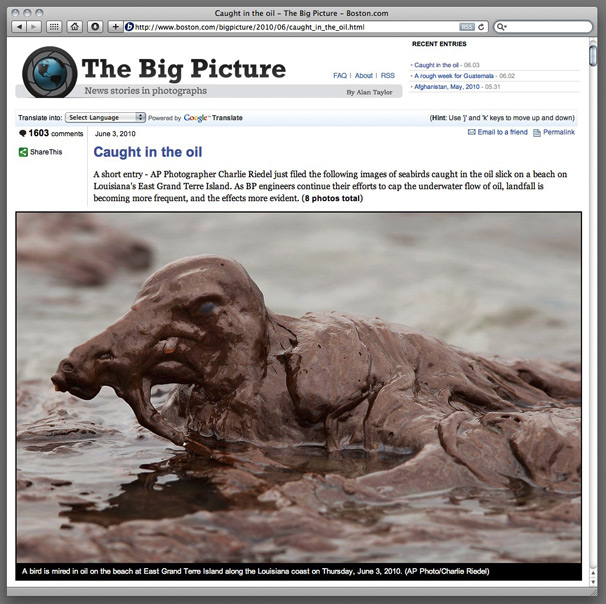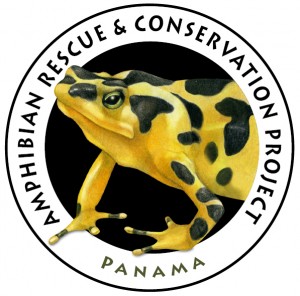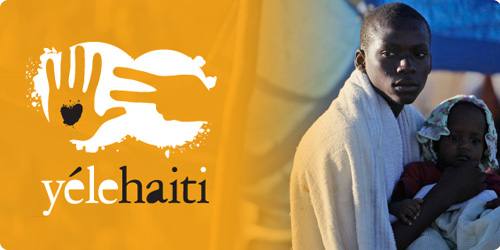Words simply can not describe how I feel about what we (yes, that's all of us) have done in the Gulf of Mexico. It's time for world leaders to summon, and unite, the thinkers of the work to stop the leak, clean-up the mess and come up with another plan for our energy and manufacturing needs of the future. Forget the blame, just get on with it! CLICK HERE TO SEE THE BIG PICTURE PHOTO ESSAY
Marsh Wren (Cistothorus palustris, Troglodyte des marais, MAWR) & Bokehlicious Backgrounds
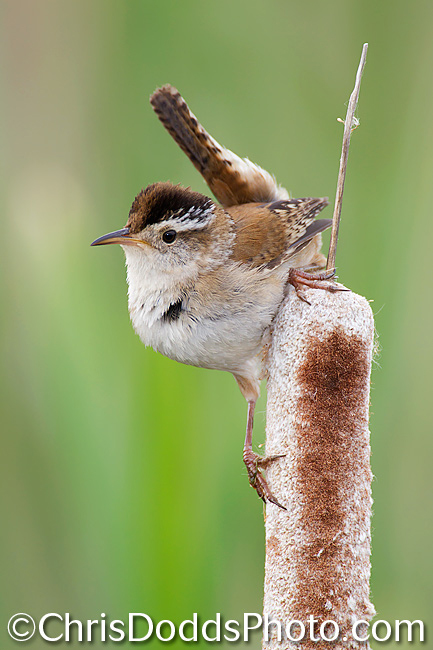
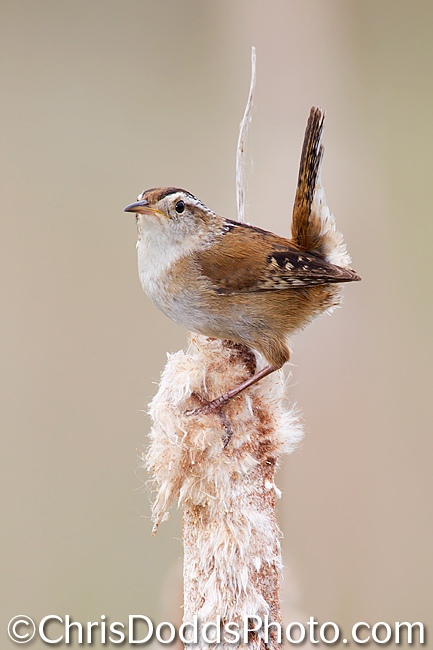
I enjoyed a great afternoon at Bois de I'Ile Bizard Nature Park, L'ile Bizard (Montreal) with clients/friends Tuma Young and Nick Honig from Halifax, NS (both of whom I’ll be seeing them again very soon at my workshop on Bonaventure Island). The star performer yesterday was surly this Marsh Wren that was building it’s nest right along the boardwalk trail.
PRO TIP: Silky Smooth Bokehlicious backgrounds for Birds
Whenever I find a co-operative subject in a place where there could potentially be a distracting, cluttered background (like a marsh full of reeds and bulrushes), I almost always immediately slap a 2X tele-converter onto my 500mm lens. I do this to take advantage of a narrower field of view (less distracting elements included in the frame) and the smaller depth of field that narrows as the focal length increases; creating smooth out-of-focus backgrounds (also known as bokeh).
Canon announces firmware update Version 2.0.7 for the EOS 5D Mark II DSLR.
his firmware update (Version 2.0.7) incorporates the following improvements and fixes.
- Fixes a phenomenon in which the aperture exhibits abnormal movement when shooting movies in manual exposure mode and Aperture Priority AE (Av mode) using some Canon lenses (such as macro lenses).
- Fixes a phenomenon in which the exposure level shown in the LCD panel differs from what is shown in the viewfinder when shooting still images in manual exposure mode.
- Fixes a phenomenon in which the Wireless File Transmitter (WFT-E4 or WFT-E4 II) may not automatically power off when used for FTP transfers.
These phenomena only occur with the Version 2.0.4 and Version 2.0.3 firmware. The Version 2.0.7 firmware being released this time is for cameras with firmware up to Version 2.0.4. If the camera's firmware is already Version 2.0.7, it is not necessary to update the firmware.
To find out the exact download instructions and to download EOS 5D Mark II firmware Version 2.0.7 please click here. Please note that before downloading firmware Version 2.0.7 you should read the entire contents of the page linked to above.
For all current Canon EOS firmware downloads please click here.
Marsh Wren (Cistothorus palustris, Troglodyte des marais, MAWR)
The Marsh Wren (Cistothorus palustris, Troglodyte des marais, MAWR) is a small North American songbird of the wren family. It is sometimes called Long-billed Marsh Wren to distinguish it from the Sedge Wren, also known as Short-billed Marsh Wren. The Marsh Wren is a secretive bird; even when singing the territorial male remains well hidden, briefly climbing a cattail for a look at an intruder. Males destroy eggs and nestlings of neighboring birds. They will even attack their own eggs if the female is removed from the nest. This behavior reduces competition for food in their area.
Adults have brown upper-parts with a light brown belly and flanks and a white throat and breast. The back is black with white stripes. They have a dark cap with a white line over the eyes and a short thin bill. Bewick's Wren is similar but has unstreaked back. Sedge Wren has less distinct supercilium and streaked crown.
The male's song is a loud gurgle used to declare ownership of territory; western males have a more varied repertoire. Learning continues throughout their adult life; it has been shown they will imitate songs presented to them on a tape recording or by a live tudor.
Their breeding habitat is marshes with tall vegetation such as cattails across North America. In the western United States, some birds are permanent residents. Other birds migrate to marshes and salt marshes in the southern United States and Mexico.
These birds forage actively in vegetation, sometimes flying up to catch insects in flight. They mainly eat insects, also spiders and snails.
The nest is an oval lump attached to marsh vegetation, entered from the side. The clutch is normally 4–6 eggs, though the number can range from 3–10. The male builds many unused nests in his territory; he may puncture the eggs of other birds nesting nearby.
This bird is still common, although its numbers have declined with the loss of suitable wetland habitat. Wholesale draining of marshes will lead to local extinction. Still, this species is widespread enough not to qualify as threatened according to the IUCN.
Black-and-White Warbler (Mniotilta varia, Paruline noir et blanc, BAWW)
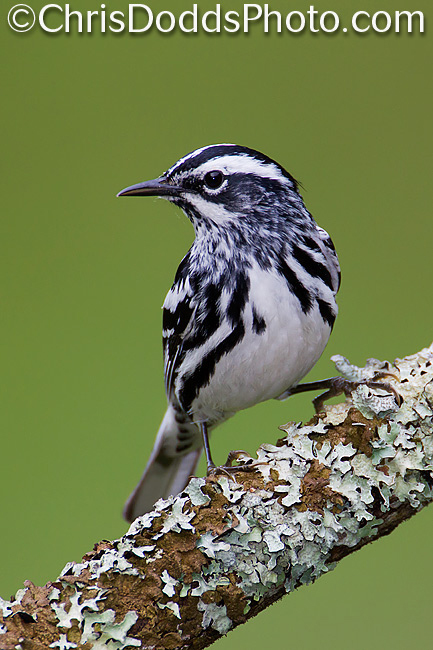
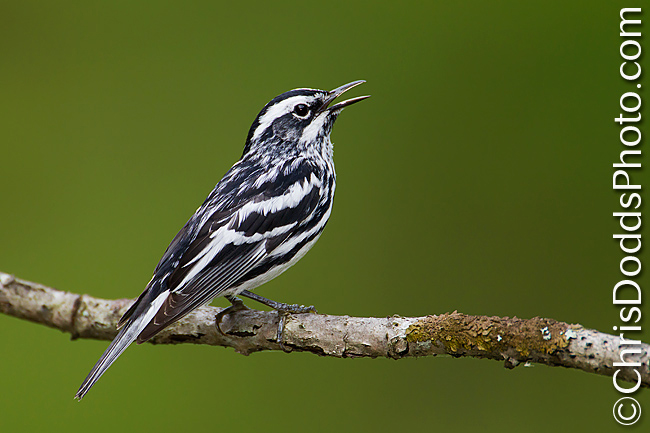
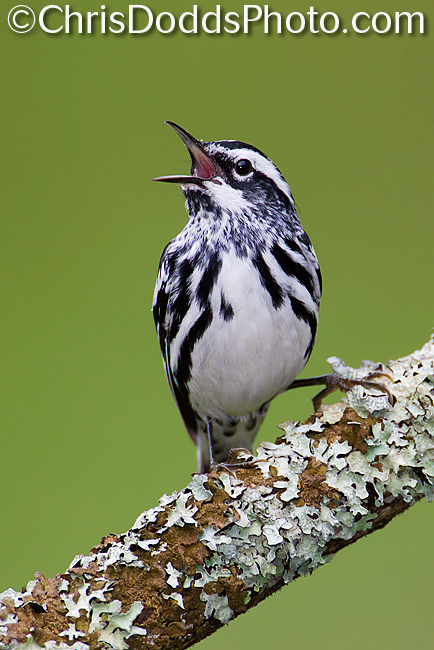
Point Pelee Workshop report ... continued
In keeping with tradition, my annual bird photography workshop at the Southernmost tip of land in Canada, Point Pelee National Park of Canada, kept us all on our feet for hours at a time. We hiked far and wide while carrying our camera gear; Robert Parent (from Quebec) called it "Extreme Bird Photography". I would hate to think just how far we really did walk each day. Everyone in the group remained in good spirits, despite the cold, and sometimes wet, weather. These images of this Black-and-white Warbler were all made within minutes of each other, they are the same bird we found foraging a pile of discarded sticks along Woodland trail early in the workshop. I enjoyed using the relatively noiseless high ISO capabilities of Canon's newset professional camera body, the Canon EOS 1D mark IV. I have always forced myself to never use more than ISO 400 with it's predecessor, so pulling-off consitently sharp images in low light during this trip was much easier than with earlier cameras.
Canon Auto-focus, Instruction book, firmware, and LensAlign
I was sitting on the tram on the way to the tip discussing Canon's latest camera bodies when a well known photographer said that he wasn't happy with the 7D he had purchased for his wife. Quick check of the custom settings showed it still had the old firmware, few of the custom functions had been properly set-up , the camera was even set to sRGB colorspace and there had been no micro-adjustment made. I downloaded the latest firmware that night and installed it the next morning for him; making a few adjustments to his custom settings. "Its much better now" was shouted-out across the parking lot that afternoon.
Perhaps Canon unleashed a beast when they decided to offer such a wide variety of user defined custom functions; few people read the instruction manual and really know how to set them. Before you decide that your camer'a AF isn't working properly, take the time to make sure it is set-up and be sure to micro-calibrate each of your lenses using LensAlign Pro.....please!
Black-and-White Warbler (Mniotilta varia, Paruline noir et blanc, BAWW)
The Black-and-white Warbler, Mniotilta vary, Paruline noir et blanc, BAWW, has an unusually long hind toe and claw on each foot. This adaptation allows it to move securely on the surface of tree bark. They are known for their habit of creeping around tree trunks and along larger branches in search of insect food in crevices or under the bark; hence its old name, "Black-and-white Creeper." Unlike the Brown Creeper, which only moves up a tree, the Black-and-white Warbler can climb in any direction. Unusually aggressive for a warbler, the Black-and-white Warbler sometimes attacks and fights Red-breasted Nuthatch, Black-capped Chickadee, Tennessee Warbler, and other species. It is the only member of the genus Mnitila, which means "moss plucking".
Gannets Galore Bird Photography Photo Tour / Workshop / Safari June 10-12 & August 13-15, 2010
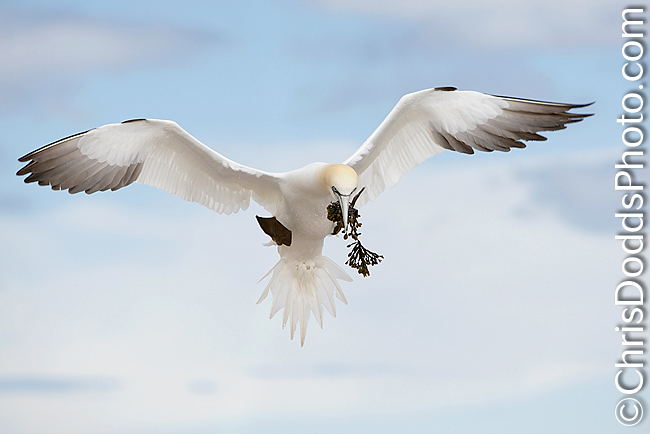
Gannets Galore Bird Photography Photo Tour / Workshop / Safari June 10-12 & August 13-15, 2010
I still have limited space available for my June 10-12 and August 13-15, 2010 Gannets Galore Photo Tour / Workshop / Safari (June 14-16 & 18-20 are SOLD OUT; Thanks to those who registered). This is THE best place on earth to learn the art of avian photography. There is non-stop action and a plethora of artistic models at close range. Sure to be the photographic adventure of your lifetime, the daily (weather permitting) four hour Zodiac cruise under the largest Northern Gannet colony in the world offers close views of thousands of Black-legged Kittiwakes, Common Murres, Razorbills, grey seals & whales and, of course, diving Gannets.
Be sure to read client TESTIMONIALS HERE
JUNE 10-12, 2010 GANNETS GALORE INFORMATION HERE
AUGUST 13-15, 2010 GANNETS GALORE INFORMATION HERE
Lincoln's Sparrow & Point Pelee Workshop / Safari Report
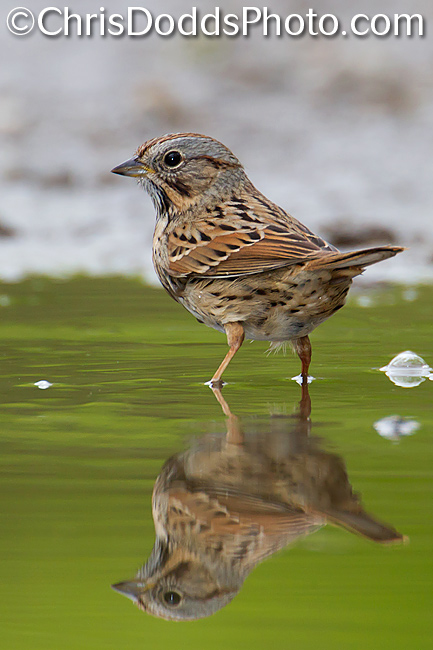
Point Pelee Spring Songbird bird photography workshop / safari report
Just back from leading my annual spring bird photography workshop / safari at Point Pelee National Park near Leamington, Ontario. I was joined by Robert Parent & Sylvie Desjardins of Lac-Beauport (Quebec), Gail Bisson of Sydney (Nova Scotia), Multiple workshop veterans (and friends) Rick & Melody Curtis of Flower Mound (Texas) and Jerry Purdy of Kalamazoo (Michigan); a fine crew. There was lots of speculation about what kind of photography would be possible with the early leaf-out and unusually warm spring. Things did start slowly and, in keeping with tradition Jerry Purdy had to leave early to take care of business; sparking the start to the best spring migration I've ever witnessed at Point Pelee (sorry Jerry). The days are all blurred into one in my memory, but once things got started, the quantity and quality of birds dripping out of trees keep increasing. Unfortunately, the most memorable moments were the afternoon after the workshop had ended, so only Rick and Melody Curtis joined Julie and I for the dozens of Blackburnian Warblers dripping from the trees in Tilden Woods that afternoon. The next morning brought a gorgeous male Kirtland's Warbler that stuck around all day on East beach. Suffice it to say; it was the best I have ever seen it at Point Pelee! My only wish would have been for everyone in the workshop to have witnessed Pelee's best.Lincoln's Sparrow , Melospiza lincolnii (Bruant de Lincoln) Point Pelee National Park of Canada (Southwestern Ontario, Canada). Image Copyright ©Christopher Dodds www.chrisdoddsphoto.com All Rights Reserved. Canon EOS-1D MKIV, 500mm F4L IS USM and 2X II Tele-extender. ISO 800, 1/200s F9. Canon 580 EX II Flash in manual mode. Tripod and Wimberley Head II. CLICK HERE TO PURCHASE A PRINT or LICENSE IMAGE FOR PUBLICATION.
Hydrophobia to the rescue
The weather ranged from cold to freezing cold with a fair mix of rain and cloud. Greg Downing (NatureScapes.net) and Bian Erwin (Think-Tank Photo) conspired to send me a rather thoughtful assortment of rain gear for my camera as an early birthday gift (it was my birthday on May 6 when I drove to Pelee); suffice it to say that their timing was impeccable and the Hydrophobia 300-600, Hydrophobia 70-200 & Hydrophobia 70-200 Flash were all put to good use - watch for a full review after more field testing during my Bonaventure Island Gannets Galore workshop series in June. We even endured hail and sleet between a rather monsoonish downpour while photographing at our set-ups at Rondeau Provincial Park. This gear is the ONLY camera rain covers that have ever worked for me; Thank-you Greg & Brian.
Kudos...
"Hey Chris,
We wanted to thank you for the great time and wonderful experience. It was just awesome to see so many birds including all the Warblers and Tanagers all in one area. "I got a feeling" that having the rare opportunity to photograph and hear the Kirkland Warbler singing was an experience that many birders would have been very envious of. The Yellow Billed Cuckoo was outstanding to see and we were got some marvelous shots even for the Texas Zoomers. We had the opportunity to take great shots of the Northern Parula, Tennessee, Chestnut-sided, Black-throated Blue, Cape May, Black-throated Green, Blackburnian, Pine, Black-and-white and American Redstart Warblers. We saw many other birds and Warblers adding to the excitement of the workshop (even the "OMG" Bay-breasted Warbler).
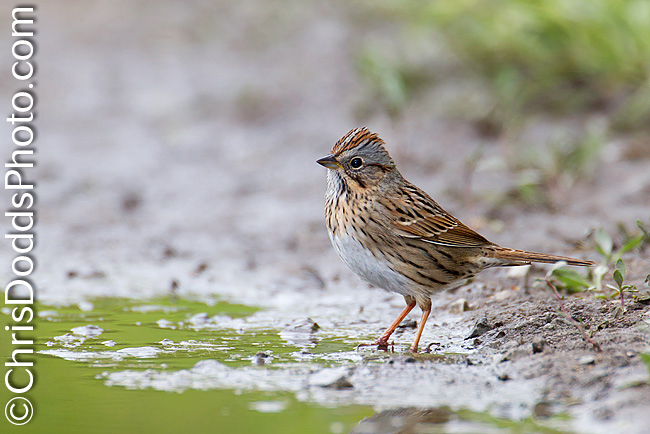
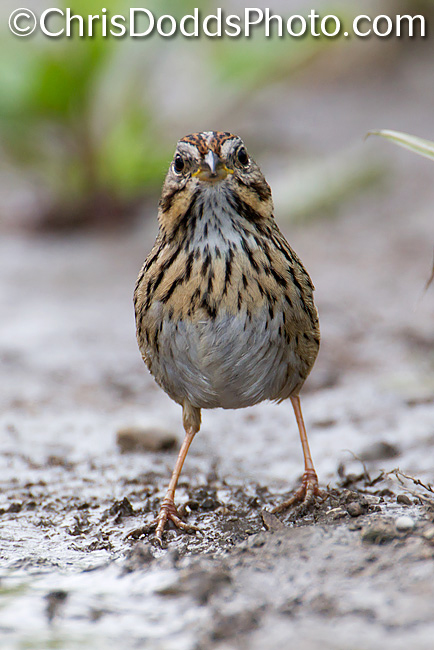
Lincoln's Sparrow Melospiza lincolnii (Bruant de Lincoln, LISP)
A species only seen during migration for most Great Lakes Region birder, William Brewster (1936, in Bent 1968) describes the Lincoln's Sparrow as "a keen, intelligent little traveler, evidently, quite alive to the fact that dangers threatened at all times, but too cool-headed and experienced to be subject to the needless and foolish panics which seize upon many of the similar birds." Lincoln's Sparrows are remarkable for staying well hidden, but a careful observer, with patience, can often get quite a good look. These Sparrows often raise their crown feathers when alert or concerned, giving their heads a bit of a peaked appearance. The Lincoln's Sparrow, Melospiza lincolnii, bruant de lincoln, is a medium-sized sparrow. Adults have dark-streaked olive-brown upperparts with a light brown breast with fine streaks, a white belly and a white throat. They have a brown cap with a grey stripe in the middle, olive-brown wings and a narrow tail. Their face is grey with brown cheeks, a brown line through the eye and an eye ring. They are somewhat similar in appearance to the Song Sparrow. Their breeding habitat is wet thickets or shrubby bogs across Canada, Alaska and the northeastern and western United States; this bird is less common in the eastern parts of its range. The nest is a well-concealed shallow open cup on the ground under vegetation. These birds migrate to the southern United States, Mexico and northern Central America; they are passage migrants over much of the United States, except in the west. They forage on the ground in dense vegetation, mainly eating insects and seeds.
They are very secretive. Their song is a musical trill, but this bird is often not seen or heard even where they are common. This bird was named by Audubon after his friend, Thomas Lincoln, of Dennysville, Maine. Lincoln shot the bird on a trip with Audubon to Nova Scotia in 1834, and Audubon named it "Tom's Finch" in his honor.
Great Grey Owls IN LOVE & Canon EF 100-400mm f/4.5-5.6 L IS USM Lens saves the day
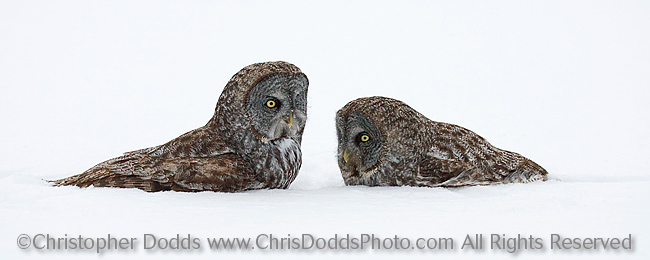 Great Grey Owls IN LOVE (Strix nebulosa Chouette Lapone) January 2005 Bracebridge, Ontario, Canada ©Christopher Dodds http://www.chrisdoddsphoto.com All Rights Reserved. Canon EOS 1D Mark II, 100-400mm @ 120mm. ISO 250, F6.3 1/800s Manual Exposure. CLICK HERE TO PURCHASE A PRINT or LICENSE IMAGE FOR PUBLICATION.
Great Grey Owls IN LOVE (Strix nebulosa Chouette Lapone) January 2005 Bracebridge, Ontario, Canada ©Christopher Dodds http://www.chrisdoddsphoto.com All Rights Reserved. Canon EOS 1D Mark II, 100-400mm @ 120mm. ISO 250, F6.3 1/800s Manual Exposure. CLICK HERE TO PURCHASE A PRINT or LICENSE IMAGE FOR PUBLICATION.
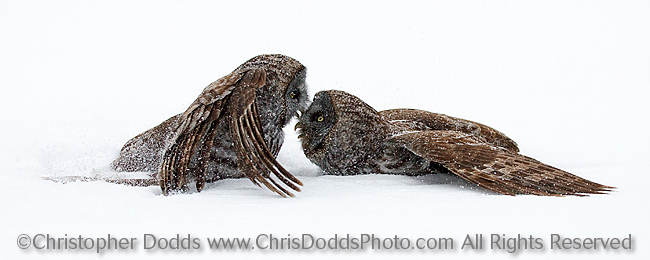 Great Grey Owls IN LOVE (Strix nebulosa Chouette Lapone) January 2005 Bracebridge, Ontario, Canada ©Christopher Dodds http://www.chrisdoddsphoto.com All Rights Reserved. Canon EOS 1D Mark II, 100-400mm @ 120mm. ISO 250, F6.3 1/800s Manual Exposure. CLICK HERE TO PURCHASE A PRINT or LICENSE IMAGE FOR PUBLICATION.
Great Grey Owls IN LOVE (Strix nebulosa Chouette Lapone) January 2005 Bracebridge, Ontario, Canada ©Christopher Dodds http://www.chrisdoddsphoto.com All Rights Reserved. Canon EOS 1D Mark II, 100-400mm @ 120mm. ISO 250, F6.3 1/800s Manual Exposure. CLICK HERE TO PURCHASE A PRINT or LICENSE IMAGE FOR PUBLICATION.
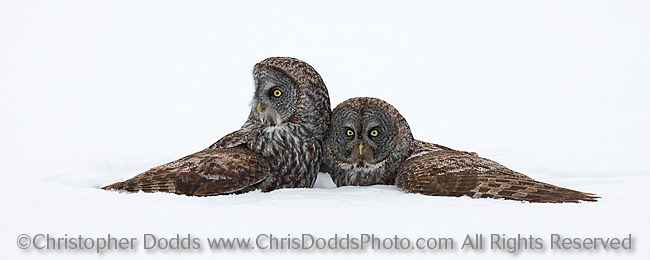 Great Grey Owls IN LOVE (Strix nebulosa Chouette Lapone) January 2005 Bracebridge, Ontario, Canada ©Christopher Dodds http://www.chrisdoddsphoto.com All Rights Reserved. Canon EOS 1D Mark II, 100-400mm @ 120mm. ISO 250, F6.3 1/800s Manual Exposure. CLICK HERE TO PURCHASE A PRINT or LICENSE IMAGE FOR PUBLICATION.
Great Grey Owls IN LOVE (Strix nebulosa Chouette Lapone) January 2005 Bracebridge, Ontario, Canada ©Christopher Dodds http://www.chrisdoddsphoto.com All Rights Reserved. Canon EOS 1D Mark II, 100-400mm @ 120mm. ISO 250, F6.3 1/800s Manual Exposure. CLICK HERE TO PURCHASE A PRINT or LICENSE IMAGE FOR PUBLICATION.
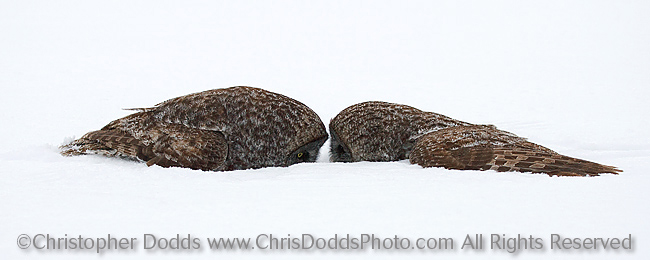 Great Grey Owls IN LOVE (Strix nebulosa Chouette Lapone) January 2005 Bracebridge, Ontario, Canada ©Christopher Dodds http://www.chrisdoddsphoto.com All Rights Reserved. Canon EOS 1D Mark II, 100-400mm @ 120mm. ISO 250, F6.3 1/800s Manual Exposure. CLICK HERE TO PURCHASE A PRINT or LICENSE IMAGE FOR PUBLICATION.
Great Grey Owls IN LOVE (Strix nebulosa Chouette Lapone) January 2005 Bracebridge, Ontario, Canada ©Christopher Dodds http://www.chrisdoddsphoto.com All Rights Reserved. Canon EOS 1D Mark II, 100-400mm @ 120mm. ISO 250, F6.3 1/800s Manual Exposure. CLICK HERE TO PURCHASE A PRINT or LICENSE IMAGE FOR PUBLICATION.
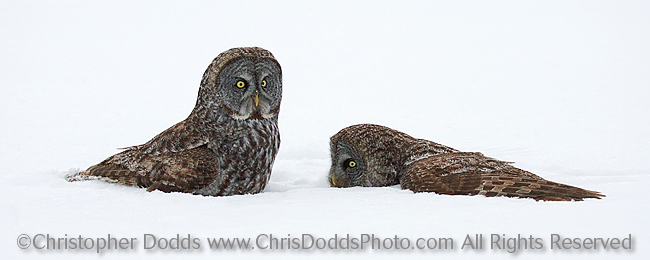 Great Grey Owls IN LOVE (Strix nebulosa Chouette Lapone) January 2005 Bracebridge, Ontario, Canada ©Christopher Dodds http://www.chrisdoddsphoto.com All Rights Reserved. Canon EOS 1D Mark II, 100-400mm @ 120mm. ISO 250, F6.3 1/800s Manual Exposure. CLICK HERE TO PURCHASE A PRINT or LICENSE IMAGE FOR PUBLICATION.
Great Grey Owls IN LOVE (Strix nebulosa Chouette Lapone) January 2005 Bracebridge, Ontario, Canada ©Christopher Dodds http://www.chrisdoddsphoto.com All Rights Reserved. Canon EOS 1D Mark II, 100-400mm @ 120mm. ISO 250, F6.3 1/800s Manual Exposure. CLICK HERE TO PURCHASE A PRINT or LICENSE IMAGE FOR PUBLICATION.
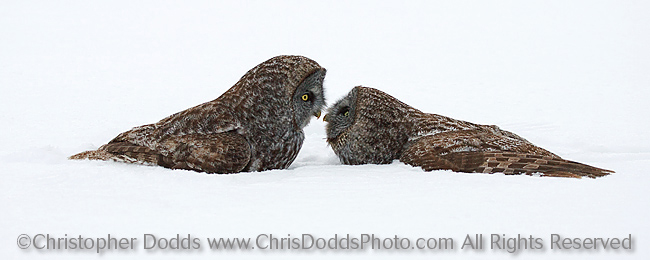 Great Grey Owls IN LOVE (Strix nebulosa Chouette Lapone) January 2005 Bracebridge, Ontario, Canada ©Christopher Dodds http://www.chrisdoddsphoto.com All Rights Reserved. Canon EOS 1D Mark II, 100-400mm @ 120mm. ISO 250, F6.3 1/800s Manual Exposure. CLICK HERE TO PURCHASE A PRINT or LICENSE IMAGE FOR PUBLICATION.
Great Grey Owls IN LOVE (Strix nebulosa Chouette Lapone) January 2005 Bracebridge, Ontario, Canada ©Christopher Dodds http://www.chrisdoddsphoto.com All Rights Reserved. Canon EOS 1D Mark II, 100-400mm @ 120mm. ISO 250, F6.3 1/800s Manual Exposure. CLICK HERE TO PURCHASE A PRINT or LICENSE IMAGE FOR PUBLICATION.
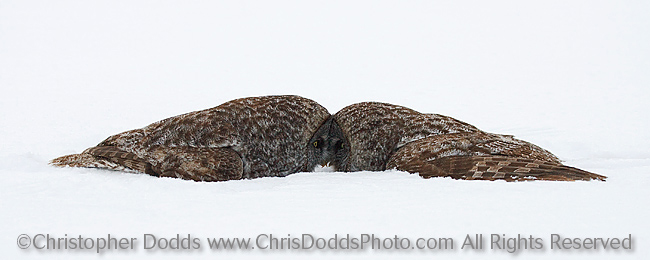 Great Grey Owls IN LOVE (Strix nebulosa Chouette Lapone) January 2005 Bracebridge, Ontario, Canada ©Christopher Dodds http://www.chrisdoddsphoto.com All Rights Reserved. Canon EOS 1D Mark II, 100-400mm @ 120mm. ISO 250, F6.3 1/800s Manual Exposure. CLICK HERE TO PURCHASE A PRINT or LICENSE IMAGE FOR PUBLICATION.
Great Grey Owls IN LOVE (Strix nebulosa Chouette Lapone) January 2005 Bracebridge, Ontario, Canada ©Christopher Dodds http://www.chrisdoddsphoto.com All Rights Reserved. Canon EOS 1D Mark II, 100-400mm @ 120mm. ISO 250, F6.3 1/800s Manual Exposure. CLICK HERE TO PURCHASE A PRINT or LICENSE IMAGE FOR PUBLICATION.
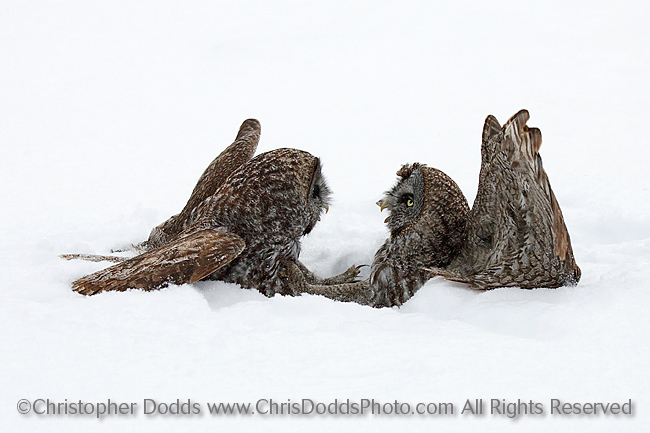 Great Grey Owls IN LOVE (Strix nebulosa Chouette Lapone) January 2005 Bracebridge, Ontario, Canada ©Christopher Dodds http://www.chrisdoddsphoto.com All Rights Reserved. Canon EOS 1D Mark II, 100-400mm @ 120mm. ISO 250, F6.3 1/800s Manual Exposure. CLICK HERE TO PURCHASE A PRINT or LICENSE IMAGE FOR PUBLICATION.
Great Grey Owls IN LOVE (Strix nebulosa Chouette Lapone) January 2005 Bracebridge, Ontario, Canada ©Christopher Dodds http://www.chrisdoddsphoto.com All Rights Reserved. Canon EOS 1D Mark II, 100-400mm @ 120mm. ISO 250, F6.3 1/800s Manual Exposure. CLICK HERE TO PURCHASE A PRINT or LICENSE IMAGE FOR PUBLICATION.
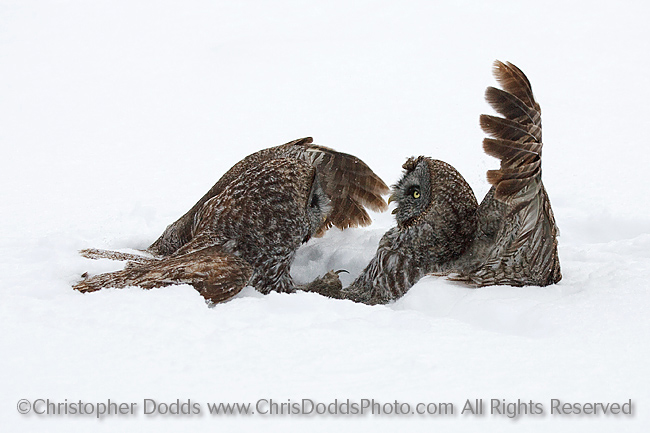 Great Grey Owls IN LOVE (Strix nebulosa Chouette Lapone) January 2005 Bracebridge, Ontario, Canada ©Christopher Dodds http://www.chrisdoddsphoto.com All Rights Reserved. Canon EOS 1D Mark II, 100-400mm @ 120mm. ISO 250, F6.3 1/800s Manual Exposure. CLICK HERE TO PURCHASE A PRINT or LICENSE IMAGE FOR PUBLICATION.
Great Grey Owls IN LOVE (Strix nebulosa Chouette Lapone) January 2005 Bracebridge, Ontario, Canada ©Christopher Dodds http://www.chrisdoddsphoto.com All Rights Reserved. Canon EOS 1D Mark II, 100-400mm @ 120mm. ISO 250, F6.3 1/800s Manual Exposure. CLICK HERE TO PURCHASE A PRINT or LICENSE IMAGE FOR PUBLICATION.
LEARN ABOUT MY WINTER SNOWY OWL WORKSHOPS HERE
Canon EF 100-400mm f/4.5-5.6 L IS USM Lens saves the day!
There’s no shortage of critics when it comes to Canon’s EF 100-400mm f/4.5-5.6 L IS USM Lens; just google it and see how many people complain about the image quality and an apparent lack of consistently sharp results from one copy to another. I’m not about to try to convince you it is as sharp as my primary telephoto 500mm F4 IS USM lens, because it isn’t! It is a sharp lens, and a very versatile one to carry over your shoulder on a second camera body.The Canon EF 100-400mm f/4.5-5.6 L IS USM Lens has, perhaps, the most useful focal length range that includes the longest focal length found in a Canon zoom lens - 400mm. This long focal length and focal length range combine with very good image and build quality to make the 100-400 one of the most popular serious wildlife and sports lenses Canon sells
While photographing Great Grey Owls in Quebec and Ontario during the great irruption that occurred during the winter of 2004-2005, I always had my second camera body mounted on my trusty EF 100-400mm f/4.5-5.6 L IS USM lens, and many of the images I made with it have since been published around the globe and have been amongst my most successful print sales. Simply put: this is perhaps the most special moment I've witnessed in nature (and there have been many), and without the versatility of this zoom lens, it would have been missed. There are very few people on this earth that have witnessed this behaviour, and even fewer that have photographed it. You see, I was walking around with my 500mm and a 2X tele-extender, so the resulting images would have been very, very different.
In my mind, there simply is no other lens out there that offers so much versatility for your money. Canon has been busy replacing many of their lenses with new, improved optics, coatings and adding the latest image stabilizer systems; I do hope that they have a version II in the plans soon, all good things can be better, but the sequence of events recorded above (and the 51 other images in it) would not have been possible without it.
The Great Grey Owl
The Great Grey Owl or Lapland Owl (Strix nebulosa, Chouette lapone) is a very large owl, distributed across the Northern Hemisphere. In some areas it is also called the Great Gray Ghost, Phantom of the north, Cinerous Owl, Spectral Owl, Lapland Owl, Spruce Owl, Bearded Owl and Sooty Owl.
Courtship involves feeding and mutual preening between mates and begins in midwinter. The male typically approaches the female, holding food in its beak, which is passed with both birds closing their eyes. The male selects possible nest sites and attracts its mate with calls. Several sites are inspected before she chooses the nest site. The Great Gray Owl nests primarily in stick nests made by hawks, ravens, or crows, in the hollowed out top of large-diameter snags, or on the top of clumps of mistletoe, and in Europe sometimes on the forest floor. Northern Goshawks are very common providers of nest sites for Great Gray Owls. They also readily take to artificial platforms or nests placed in suitable habitat. Nests are usually in a forest, but with a large clearing or meadow located within 1.3km (0.8 miles). Unlike most other Owls, nests are usually tidied up and refurbished before use. Nest linings include conifer needles, deer hair, moss, and shredded bark. 2 to 5 (average 3) eggs are laid, each separated by 1 to 2 days. Incubation commences with the first egg laid and lasts 28 to 29 days. The female does all incubation and the male provides all food to the female and young. The female tears food into small pieces and feeds the young. Young leave the nest at 3 to 4 weeks and can climb well. Fledging occurs after about 8 weeks and young remain near the nest for several months, with the female caring for them.
Great Gray Owls are single-brooded but will readily lay replacement clutches if the first clutch or brood is lost. Males and females aggressively defend nests and have been known to drive off predators as large as black bears. Among other threats, ravens and Great Horned Owls prey on eggs and nestlings.
Great Gray Owls are semi-nomadic, with irregular site or mate fidelity between years. They tend to settle and nest in areas with high food resources and this may lead them to occupy the same nest for several years or move off to new areas. Nesting territories are defended from other Great Gray Owls, but foraging areas are widely overlapping. This leads to higher than expected densities, for a large bird of prey. In areas of good habitat this may be as high as 1 pair/58 hectares (5 pairs/square mile).
These birds wait, listen, and watch for prey, then swoop down; they also may fly low through open areas in search of prey. Their large facial disks, also known as "ruffs", focus sound, and the asymmetrical placement of their ears assists them in locating prey, because of the lack of light during the late and early hours in which they hunt. On the nesting grounds, they mainly hunt at night and near dawn and dusk; at other times, they are active mostly during the night. They have excellent hearing, and may locate (and then capture) prey moving beneath 60 cm (2 feet) of snow in a series of tunnels solely with that sense. These owls can crash through snow that could support the weight of a 180-pound person.[citation needed] Unlike the more versatile eagle and horned owls, Great Grey Owls rely almost fully upon small rodents, with voles being their most important food source. Locally, alternative prey animals (usually comprising less than 20% of prey intake) include hares, moles, shrews, weasels, thrushes, grouse, Gray Jays, small hawks and ducks. Great Grey Owl juveniles may themselves fall prey to bears, fishers, and large hawks, especially Northern Goshawks; while adults may fall prey to Bubo owls and lynxes.
Every few years, great grey owls move—usually en masse—from their boreal breeding grounds, typically in search of food. The last great irruption (as these movements are called) happened in 2004-2005. It was so large that it caught the attention of photographers, bird lovers, environmentalists, and the mainstream media from around the world.
Please note Canon released an updated version of the Canon EF 100-400mm f/4.5/5.6 L IS II. My mini-review can be found HERE
The Northern Parula & Canon Professional Services (CPS) Revamped
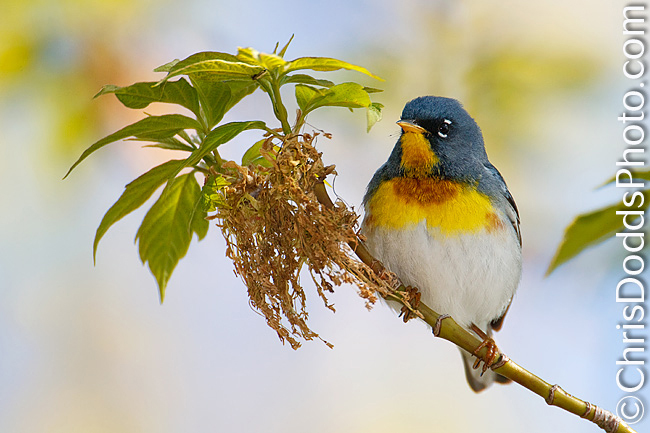 Northern Parula Male , Parula americana (Paruline à collier) Point Pelee National Park of Canada (Southwestern Ontario, Canada). Image Copyright ©Christopher Dodds www.chrisdoddsphoto.com All Rights Reserved. Canon EOS-1D MKIII, 500mm F4L IS USM and 2X II Tele-extender. ISO 400, 1/500s F9 Manual mode. Canon 580 EX II Flash in manual mode. Tripod and Wimberley Head II. CLICK HERE TO PURCHASE A PRINT or LICENSE IMAGE FOR PUBLICATION.
Northern Parula Male , Parula americana (Paruline à collier) Point Pelee National Park of Canada (Southwestern Ontario, Canada). Image Copyright ©Christopher Dodds www.chrisdoddsphoto.com All Rights Reserved. Canon EOS-1D MKIII, 500mm F4L IS USM and 2X II Tele-extender. ISO 400, 1/500s F9 Manual mode. Canon 580 EX II Flash in manual mode. Tripod and Wimberley Head II. CLICK HERE TO PURCHASE A PRINT or LICENSE IMAGE FOR PUBLICATION.
Just going through some images from last year's Point Pelee bird photography workshop while preparing for this years. Photographing migrant Warblers is probably the most challenging type of bird photography; there is no food, bird calls or water drips to attract your subject. There's no choosing nice perches, and choosing great backgrounds is a result of your ability to move faster than your speedy subject. Migrant bird photography at a place like Pelee can be quite rewarding, though, many of the tree-top dwellers forage for fuel at near eye-level while migrating. The total number of bird species recorded at Point Pelee is 372, of which at least 340 of these species have been recorded during the spring migration period. The stream of birds in the spring is not a steady flow from the south. The birds usually arrive in intermittent waves, a pattern unique to eastern North America. In some years these are well marked but, in others the fluctuations in numbers and variety is so meagre that a wave in difficult to detect. A "wave" occurs as a result of a warm weather front advancing from the south or southeast meeting a cold weather front from the north or northwest. Two situations will cause the birds to descend. One is when the two fronts meet at ground level. The other is when a warm front in which migrating birds are flying overrides a cold front. The rising warm air becomes cooler with the increasing altitude until it is finally too cold for the birds and they descend.
If these nocturnal (night-time) migrants find themselves over Lake Erie near sunrise they must continue onwards or drown. After flying perhaps hundreds of kilometres in one night, it is this extra 30 to 40 kilometres across the lake that really demands their last strength. This explains why exhausted birds are sometimes found at the tip of the Point. A similar situation, but on a larger scale, occurs when migrants cross the 800 to 1000 kilometres of the Gulf of Mexico. If the weather is good they continue inland in one continuous flight without stopping, but with a north wind and rain they descend on the coast in great numbers, often in an exhausted state.
Do consider joining me at Point Pelee National Park this May 8-12, 2010 as I still have two spots available due to last minute cancellation. More information can be found HERE.

Canon Professional Service Revamped in Canada
Canon Canada has announced their revamped paid CPS program. Choose between Gold and platinum paid levels HERE. It seems to me that we are getting more for less, when compared the the Canon USA CPS program HERE while the Canon EUROPE CPS program is currently still offered FREE HERE.
There's a rumor circulating in Canada that the current discount on professional camera bodies and L Series lenses that Canadian CPS members currently enjoy will no longer be offered; this because there is no mention of it on the new CPS web site. Well my sources at Canon Canada tell me that CPS benefits never really did include a discount, it was offered to CPS members by the Canon Canada marketing people to offset the currency exchange rate that sent many pros across the border into the USA to shop. The good new is that the discount is still offered, and that there is no forseen end to it.
Nikon professional services, or NPS, in the USA is offered FREE HERE, in Canada, it's FREE HERE and in Europe (Nikon Professional User) it's FREE HERE
Photographing the Northern Fulmar (Fulmarus glacialis) of Iceland
Northern Fulmar Portrait , Fulmarus glacialis (Fulmar boréal) Látrabjarg, Iceland ©Christopher Dodds www.chrisdoddsphoto.com All Rights Reserved Canon EOS-1DsMKII, 300mm F2.8IS. ISO 400, 1/320s F5.6 Manual mode. Canon 550 EX Flash in manual mode. Tripod and Wimberley Head. CLICK HERE TO PURCHASE A PRINT OR LICENSE IMAGE FOR PUBLICATION.
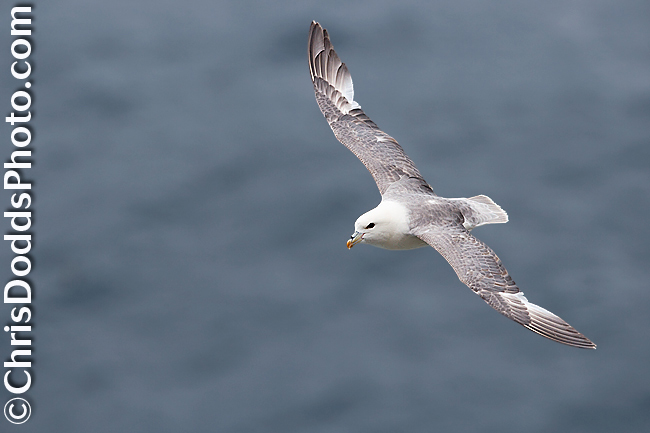
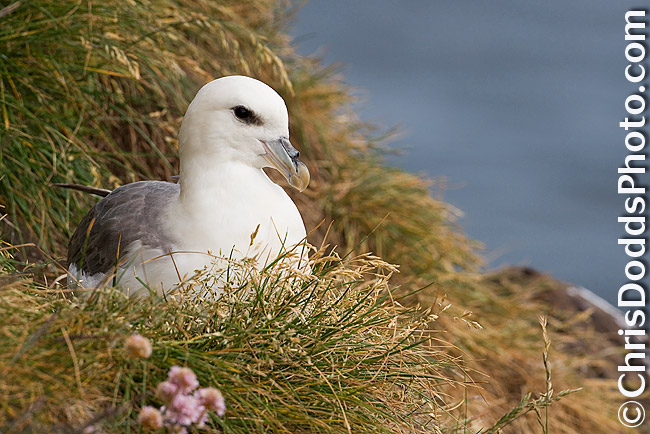
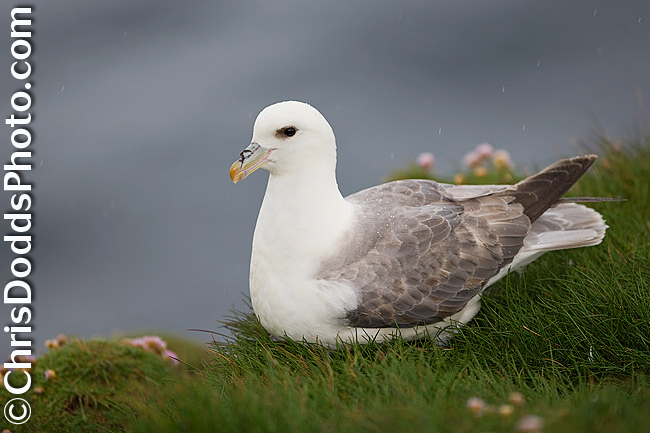
Cool Northern Fulmar Facts:
- The Northern Fulmar is one of the longest-lived birds. Data from one study indicate a mean adult life span of about 32 years. In Scotland, several Northern Fulmars banded as adults in 1951 were still breeding in 1990, at ages likely greater than 50 years.
- The Northern Fulmar begins breeding at an exceptionally old age. Most do not breed until they are at least 8 to 10 years old; one study found an individual that started breeding at age 20.
- The Northern Fulmar is well known among commercial fishermen for its avid scavenging of offal thrown from whaling and fishing boats.
- The population of Northern Fulmars in the northeast Atlantic has dramatically increased over the past 250 years. Once only one colony was found in northern Iceland, and none off the Faeroes or the British Isles. Now hundreds of colonies exist across all the coasts of these islands. It is unclear whether this change has resulted from natural oceanographic changes, from increased food availability from fishing vessels, or from some other factor.
- The Northern Fulmar can dive to a depth of at least 3 meters (10 feet).
LensFlare Live & NatureScapes Radio LIVE:
On Tuesday, April 6th, 2010, I was honoured to be the first invited guest on the new NatureScapes Radio Live. Hosted by LensFlare 35's very own Dave Warner, with Greg Downing and E.J. Peiker of NatureScapes.net. Be sure to give it a listen HERE:
Colostethus panamensis (Panama Poison Dart Frog), Panama Amphibian Rescue & Conservation Project

Photographing so many species of frogs and toads during a recent trip to Panama has been a real eye opener in so many ways. Seeing first hand how many of the amphibians that I photographed are either listed as endangered, or well on their way there, is not only disturbing, it's life changing.
Listed by the IUCN Red List as a species of least concern (2004), the Colostethus panamensis (Panama Poison Dart Frog) has since become a high priority rescue species for The Panama Amphibian Rescue and Conservation Project.
There is a silent killer wiping out the world's frogs that everyone needs to hear about. Amphibian chytrid fungus (Batrachochytrium dendrobatidis) is a lethal fungus spreading across Central America and wiping out entire populations of frogs. The Batrachochytrium dendrobatidis is so deadly that it kills about half of all amphibian species and reduces overall populations by about 80% after it’s arrival in any given place. One third of the known 5,743 amphibian species in the world are at risk of being wiped out! On a world scale, since 1980, 122 species of amphibian species have gone extinct, compared with five bird species and no mammals in the same period. Be sure to click on the Panama Amphibian Rescue & Conservation Project badge below to learn more and see how you can help.
Coyotes, Canon EOS 1D Mark IV First Impressions and NatureScapes Radio Live

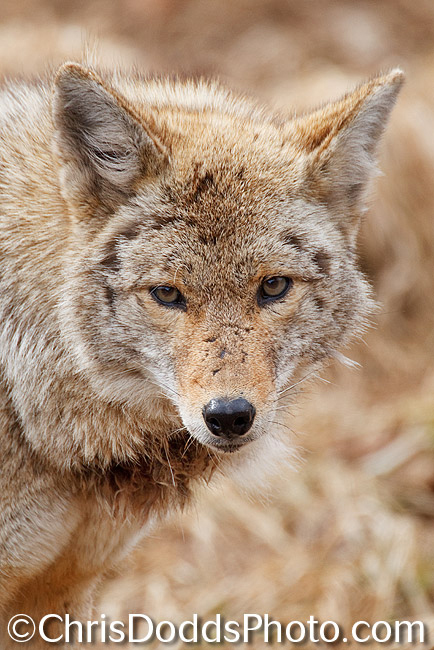

Coyote
It's amazing to see just how much this Alpha Male Eastern Coyote resembles a wolf; Coyotes have been known to occasionally mate with wolves. The offspring, known as a coywolf, are generally intermediate in size to both parents, being larger than a pure coyote, but smaller than a pure wolf. A study showed that of 100 coyotes collected in Maine, 22 had half or more wolf ancestry, and one was 89 percent wolf. A theory has been proposed that the large eastern coyotes in Canada are actually hybrids of the smaller western coyotes and wolves that met and mated decades ago as the coyotes moved toward New England from their earlier western ranges. The Red Wolf is thought by certain scientists to be in fact a wolf/coyote hybrid rather than a unique species. Strong evidence for hybridization was found through genetic testing, which showed that red wolves have only 5% of their alleles unique from either gray wolves or coyotes. Genetic distance calculations have indicated that red wolves are intermediate between coyotes and gray wolves, and that they bear great similarity to wolf/coyote hybrids in southern Quebec and Minnesota. Analyses of mitochondrial DNA showed that existing red wolf populations are predominantly coyote in origin.
Canon EOS 1D Mark IV First Impressions
I've now spent a considerable amount of time in the drivers seat of my Canon EOS 1D Mark IV and am loving every moment. From the new, and snappy, autofocus system to the superb image quality in low light at high ISO, this camera ROCKS! Be sure to download, read and digest the following from CPN Canon Professional Networks 1D Mark IV page:
- EOS-1D Mark IV – AI Servo AF Custom Functions & ISO speed settings guide (English)
- EOS-1D Mark IV – AI Servo AF Custom Functions & ISO speed settings guide (French)
Christopher Dodds on NatureScapes Radio Live April 6, 2010 @ 9PM EST!
Each month NatureScapes.net will be broadcasting a LIVE Pod Cast called "NatureScapes Radio LIVE!"
NatureScapes Radio LIVE! will air live the first Tuesday of each month at 9PM EST.
Hosted by Dave Warner of LensFlare Live each show will feature friends E.J. Peiker and Greg Downing of NatureScapes.net as well as other guest photographers TBA (Christopher Dodds on April 6th, 2010). Listen LIVE or participate in the conversation while they talk about everything nature and wildlife photography from the latest and greatest gear to techniques and important issues affecting us all.
I was thrilled to be invited as Greg and E.J.'s first featured guest and look forward to answering all of your questions live at 9PM EST on April 6th, 2010. Click HERE for more information.
Rhinelia margaritfera - South American Common Toad

KUDOS & CONGRATULATIONS
"Thank you for your marvellous Gannets Galore workshop on Bonaventure Island that my husband and I attended (June '08). The course advanced my comprehension of digital photography, and taught techniques for capturing birds in flight and in varying weather conditions. I was thrilled that one of my photos from the workshop was recognized as a "photo of the week" in the 2009 National Geographic International Photography Contest (Nature, Oct. - week 3). Your instruction was invaluable!
Thanks for sharing your invaluable expertise!"
Leslie Scopes Anderson | Arcata, CA
Thanks for writing, Leslie and congratulations! Your preening Northern Gannet portrait is well worth the honour.
Leafcutter Ants
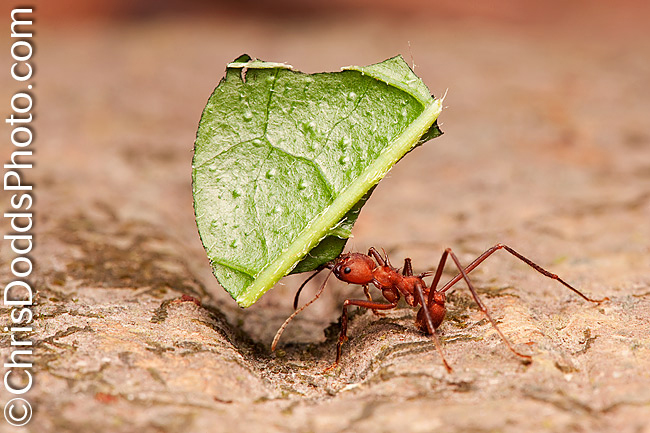
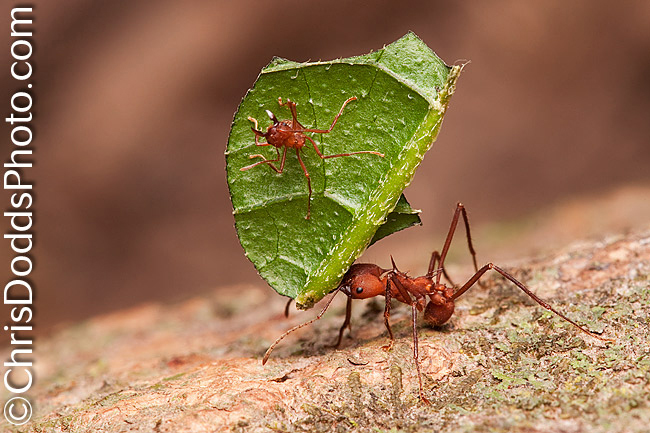

While certainly a challenging photographic subject, I managed a few decent images of these Leafcutter Ants (Leaf-cutter, Leaf-cutting). Their speed and the lack of depth-of field from my full-frame sensor camera made it quite a difficult task. I did manage to find an exposed tree root that a colony had made a trail over, and used it as a seat to save my back. All went well until I decided to get a low, intimate view and lay down on the ground - That is when I got attacked by a couple of dozen Major, or soldier, ants…….something I don't want to do again.
Canon EOS 5D Mark II Firmware Update 2.0.4
Canon has released firmware v2.0.4 for its 5D Mark II DSLR that corrects the bug found in the previous version. With v2.0.3, sound recording would not work if a manual record volume was used in the C1/C2/C3 custom settings modes. The revised firmware update addresses the issue and is now available for download from Canon's website HERE
Gannets Galore Bird Photography Safari / workshop June 10-12, 2010 & August 13-15, 2010 Just Announced!
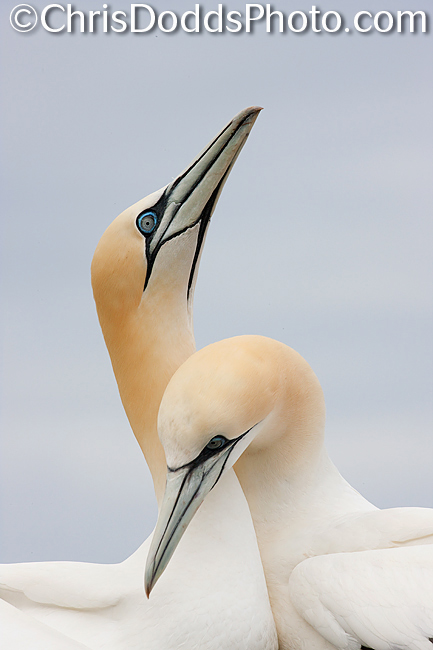 Northern Gannets SPOONING (fencing = pair bonding), Morus Bassanus, Fou de Bassan Parc national de l'Île-Bonaventure-et-du-Rocher-Percé, Bonaventure Island, Quebec Image Copyright ©Christopher Dodds www.chrisdoddsphoto.com All Rights Reserved. Canon EOS 1D S MKIII, 500mm F4 IS Gitzo 1325 tripod, Wimberley Head II. ISO 400, F18 1/200s Manual. Full Frame. Click HERE to purchase a print or license an image for publication.
Northern Gannets SPOONING (fencing = pair bonding), Morus Bassanus, Fou de Bassan Parc national de l'Île-Bonaventure-et-du-Rocher-Percé, Bonaventure Island, Quebec Image Copyright ©Christopher Dodds www.chrisdoddsphoto.com All Rights Reserved. Canon EOS 1D S MKIII, 500mm F4 IS Gitzo 1325 tripod, Wimberley Head II. ISO 400, F18 1/200s Manual. Full Frame. Click HERE to purchase a print or license an image for publication.
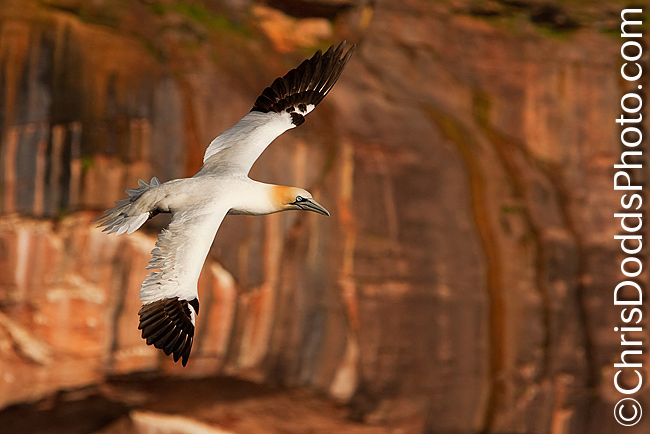 Northern Gannet Painted Flight, Morus Bassanus, Fou de Bassan Parc national de l'Île-Bonaventure-et-du-Rocher-Percé, Bonaventure Island, Quebec Image Copyright ©Christopher Dodds www.chrisdoddsphoto.com All Rights Reserved. Canon EOS 1D MKIII, 70-200mm F2.8 IS, 1.4X II Tele-Converter (270mm) Hand-held from Zodiac. ISO 250, F8 1/1600s Manual. Full Frame. Click HERE to purchase a print or license an image for publication.
Northern Gannet Painted Flight, Morus Bassanus, Fou de Bassan Parc national de l'Île-Bonaventure-et-du-Rocher-Percé, Bonaventure Island, Quebec Image Copyright ©Christopher Dodds www.chrisdoddsphoto.com All Rights Reserved. Canon EOS 1D MKIII, 70-200mm F2.8 IS, 1.4X II Tele-Converter (270mm) Hand-held from Zodiac. ISO 250, F8 1/1600s Manual. Full Frame. Click HERE to purchase a print or license an image for publication.
Gannets Galore; New Dates Added!
Due to the overwhelming popularity of my Gannets Galore Photo Safari / Workshop series (both the June 14-16, 2010 and 18-20, 2010 are SOLD OUT), I've added some new dates. June 10-12, 2010. June is the best time to photograph the thousands of Razorbills, Common Murres, Black Legged Kittiwakes, Grey Seals and thousands of adult Gannets in perfectly prime breeding plumage. Please see HERE for more information.
August 13-15, 2010 still has a few spots left; simply the best time to photograph the many thousands of baby Northern Gannets - some at just arms length.
All of the Gannets Galore series workshops / safaris include four nights hotel, 3 four hour Zodiac excursions under the colony (weather permitting) with breakfast once landed on the island, three full days photographing at the colony and expert instruction and guiding by Christopher Dodds (more than 350 days experience guiding guests on Bonaventure Island). Did I mention the motorized transportation to the colony for your heavy camera gear? - that’s just one of the little bonuses when traveling with Chris (smile).
Be sure to read the many testimonials found HERE; all real people, from real places!
How to age the Northern Gannet (Morus bassanus)
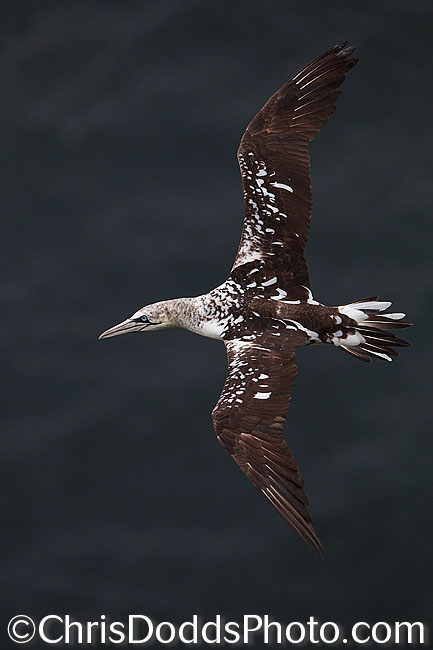
Northern Gannet second year Dorsal View, Morus Bassanus, Fou de Bassan Parc national de l'Île-Bonaventure-et-du-Rocher-Percé, Bonaventure Island, Quebec Image Copyright ©Christopher Dodds www.chrisdoddsphoto.com All Rights Reserved. Canon EOS 5D MKII, 300mm F2.8 IS Hand-held. ISO 250, F4 1/2500s Manual. Full Frame. CLICK HERE TO PURCHASE A PRINT or LICENSE IMAGE FOR PUBLICATION.
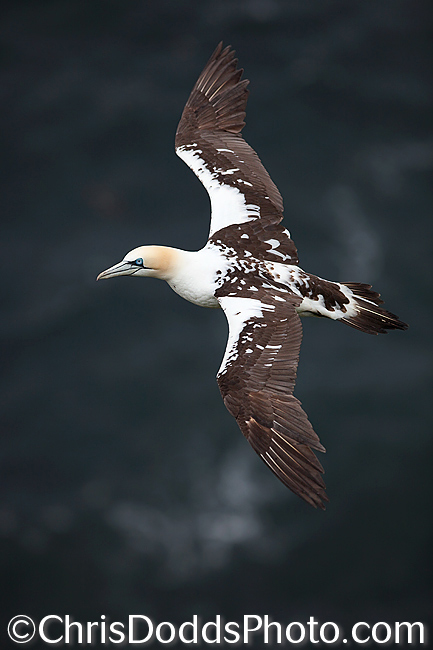
Northern Gannet third year Dorsal View, Morus Bassanus, Fou de Bassan Parc national de l'Île-Bonaventure-et-du-Rocher-Percé, Bonaventure Island, Quebec Image Copyright ©Christopher Dodds www.chrisdoddsphoto.com All Rights Reserved. Canon EOS 5D MKII, 300mm F2.8 IS Hand-held. ISO 250, F3.5 1/2500s Manual. Full Frame. CLICK HERE TO PURCHASE A PRINT or LICENSE IMAGE FOR PUBLICATION.
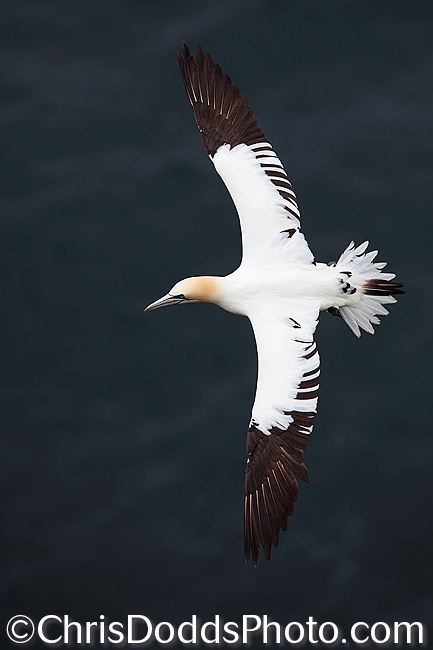
Northern Gannet fourth year Dorsal View, Morus Bassanus, Fou de Bassan Parc national de l'Île-Bonaventure-et-du-Rocher-Percé, Bonaventure Island, Quebec Image Copyright ©Christopher Dodds www.chrisdoddsphoto.com All Rights Reserved. Canon EOS 5D MKII, 300mm F2.8 IS Hand-held. ISO 250, F4 1/2500s Manual. Full Frame. CLICK HERE TO PURCHASE A PRINT or LICENSE IMAGE FOR PUBLICATION.
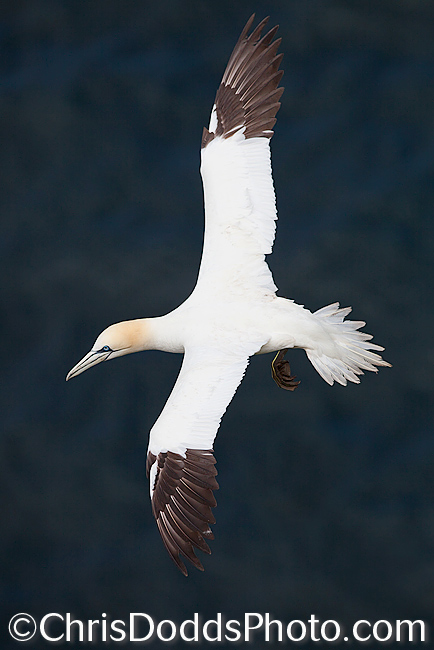
Northern Gannet fifth year Mature Adult Dorsal View, Morus Bassanus, Fou de Bassan Parc national de l'Île-Bonaventure-et-du-Rocher-Percé, Bonaventure Island, Quebec Image Copyright ©Christopher Dodds www.chrisdoddsphoto.com All Rights Reserved. Canon EOS 5D MKII, 300mm F2.8 IS Hand-held. ISO 250, F4.5 1/2500s Manual. Full Frame. CLICK HERE TO PURCHASE A PRINT or LICENSE IMAGE FOR PUBLICATION.
After spending more than 350 days ,over the years, up at the Northern Gannet colony on Bonaventure Island, I have quite a collection of images. Last year, I found a new spot to photograph vertical dorsal views of these striking seabirds. Spending time with your subject is the best way to study and learn about their every behavior. Always remember to try to cover every aspect of behavior and every age possible. Remember that you can turn your camera to vertical for a fresh perspective.
There are still a couple of spots left for the June 18-20, 2010 Gannets Galore Photo Safari Workshop
Viola Wildlife Photographer of the Year Competition
If you haven't done so already, there's still time to enter this prestigious competition. Entries can be submitted HERE until 9AM, Monday, March 8th, 2010. Be sure to read the new rules, most notably the need to submit images from a DSLR with a minimum 10 Mega pixel resolution. Why the new rules? ... Who knows? You are allowed to lightly crop your image, so perhaps the rule would have been better stated as a minimum file size, instead of making every image from the single most popular wildlife photography camera in recent history, the Canon EOS 1D Mark II (and the EOS 1D Mark IIN), ineligible.
Even when this was called the BBC Wildlife Photographer of the year, I though (and still do) that this competition should be called the wildlife IMAGE of the year competition. I really do feel that such a prestigious title should be awarded to the photographer with the best portfolio of wildlife images. One lucky shot shouldn't earn the title of Nature Photographer of the year in my humble opinion.
Canon EOS 5D Mark II Firmware Update 2.0.3
Canon has announced that the long awaited, video-related firmware for its EOS 5D Mark II will be available from mid-March. Firmware version 2.0.3 enables full 1080p HD video recording at 24, 25 and 29.97fps to match the PAL and NTSC broadcast standards. It also adds a new histogram display while shooting movies and allows users to manually control sound recording levels. Audio sampling frequency has also been increased to match broadcast material standards.
Press Release:
Canon adds 24 and 25fps HD Movie recording
to the EOS 5D Mark II with Firmware 2.0.3
London, 2nd March 2010 – Canon today pre-announces the release of a firmware update for the multiple award-winning EOS 5D Mark II. Originally announced in late 2009, the update adds 24* and 25 frames per second (fps) recording to the camera’s EOS MOVIE video function, and will be available as a free download from the middle of March.
Developed following feedback from photographers and cinematographers, Firmware 2.0.3 further enhances the EOS 5D Mark II’s excellent video performance. The addition of new frame rates expands the camera’s video potential, providing film makers with the ability to shoot 1080p Full HD footage at 24fps (actual 23.976fps) – the optimum frame rate for cinematic video. 25fps support at both 1920x1080 and 640x480 resolutions will allow users to film at the frame rate required for the PAL broadcast standard, while the new firmware will also change the 30fps option to the NTSC video standard of 29.97fps.
A new histogram display for shooting movies in manual exposure, shutter-priority (Tv) and aperture-priority (Av) have been added, and exposure modes will also be available in movie mode. Improved audio functionality will allow users to set sound record levels manually using a sound-level meter displayed on the LCD screen. The audio sampling frequency has also been increased from 44.1KHz to 48KHz, providing the optimum audio signal typically required for professional or broadcast material.
With its full frame CMOS sensor and compatibility with Canon’s wide range of premium lenses, the EOS 5D Mark II is already recognised for its outstanding HD video performance. Launched in September 2008, the camera immediately created a wide range of new possibilities for photographers and videographers, and the addition of new frame rates and manual audio levels extends those possibilities even further – allowing movie makers to shoot stunning movies to suit practically any creative purpose.
Extreme sports photographer Richard Walch was one of the first to be given the chance to use the newly updated EOS 5D Mark II to shoot the snowboarding movie “I Love My Friends”. Commenting on the EOS 5D Mark II’s video performance, Richard said: “The addition of the new frame rates opens up a whole new range of possibilities. If you’re a cinematographer, independent film maker or just enthusiastic about making your own movies, get out there and give it a try”.
“I Love My Friends” shot by Richard Walch on the EOS 5D Mark II with the new firmware includes a look behind the scenes video is available to view at http://www.canon-europe.com/eos5dmarkII.
The firmware will be available to download from mid-March from the Canon website http://www.canon.com/eos-d/
American Bald Eagles Tumbling - Breaking the rules - Save 25% off Point Pelee Annual Pass
 Bald Eagle Tumble Abstract (Haliaeetus leucocephalus Pygarge à tête blanche) Kachemak Bay, Homer Alaska, USA. ©Christopher Dodds http://www.chrisdoddsphoto.com All Rights Reserved. Canon EOS 1D Mark III, 500mm F4 IS, 1.4X II Tele-converter, Gitzo tripod and Wimberley Head II. ISO 400, F5.6 1/1600s Manual Exposure. Full Frame. Cropped from left and right to 4x5 Aspect Ratio for visual impact. BUY A PRINT OR LICENCE IMAGE FOR PUBLICATION HERE.
Bald Eagle Tumble Abstract (Haliaeetus leucocephalus Pygarge à tête blanche) Kachemak Bay, Homer Alaska, USA. ©Christopher Dodds http://www.chrisdoddsphoto.com All Rights Reserved. Canon EOS 1D Mark III, 500mm F4 IS, 1.4X II Tele-converter, Gitzo tripod and Wimberley Head II. ISO 400, F5.6 1/1600s Manual Exposure. Full Frame. Cropped from left and right to 4x5 Aspect Ratio for visual impact. BUY A PRINT OR LICENCE IMAGE FOR PUBLICATION HERE.
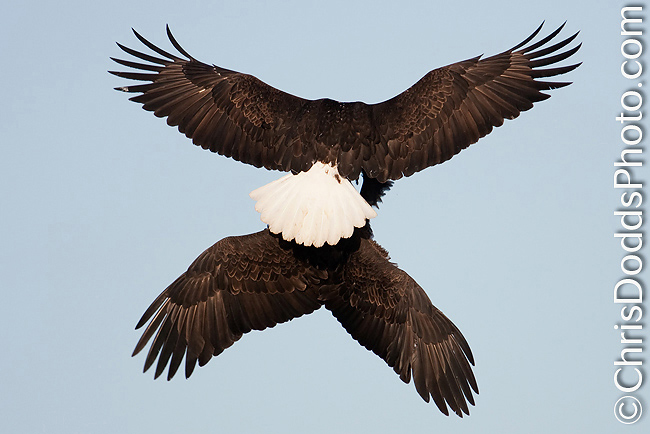 Bald Eagle Tumble Abstract (Haliaeetus leucocephalus Pygarge à tête blanche) Kachemak Bay, Homer Alaska, USA. ©Christopher Dodds http://www.chrisdoddsphoto.com All Rights Reserved. Canon EOS 1D Mark III, 500mm F4 IS, 1.4X II Tele-converter, Gitzo tripod and Wimberley Head II. ISO 400, F5.6 1/1600s Manual Exposure. Full Frame. Here is the original, un-cropped image. BUY A PRINT OR LICENCE IMAGE FOR PUBLICATION HERE.
Bald Eagle Tumble Abstract (Haliaeetus leucocephalus Pygarge à tête blanche) Kachemak Bay, Homer Alaska, USA. ©Christopher Dodds http://www.chrisdoddsphoto.com All Rights Reserved. Canon EOS 1D Mark III, 500mm F4 IS, 1.4X II Tele-converter, Gitzo tripod and Wimberley Head II. ISO 400, F5.6 1/1600s Manual Exposure. Full Frame. Here is the original, un-cropped image. BUY A PRINT OR LICENCE IMAGE FOR PUBLICATION HERE.
Breaking the rules...
I strive to always challenge myself to break the standard rules of art, composition and photography; especially when mother nature works against me. In the case of the image above, I was simply making the most of a bad situation; the wind was blowing against the afternoon sunlight and all of the other photographers had opted to take the afternoon off to rest or edit their images. I watched and saw that I might have a chance at something artsy, or abstract, to salvage the afternoon. As I typically challenge myself to compose my images in-camera and shoot full-frame, without cropping, I thought I would include the original, un-cropped version for you to see how cropping, or changing the images aspect ratio, changes the visual impact of the image. While it's generally a good idea to include your subject's face, or eyes(preferably with good eye contact); once in a very great while you can create something nice without including either.
The broken rules:
- Always photograph birds-in-flight with the wind and sun at your back.
- Always include your subject's face
- Always ensure at least one eye is critically sharp & in-focus
- Always ensure strong eye contact between viewer and subject
- always follow the rules
Kudos
"I wanted to thank you for a wonderful owling trip last week. It was great to be in the field with you and I learned a great deal about the birds, environment and my camera. Thanks so much for being such a great naturalist, photographer and trip leader. I will go on another trip with you in the future." - Lynda Goff Santa Cruz, CA (Professor Emeritus Ecology & Evolutionary Biology UC Santa Cruz)
Save 25% on your Season pass to Point Pelee National Park of Canada
Buy or renew your annual pass to Point Pelee National Park of Canada and save 25%. From February 1, until March 31, 2010, take advantage of this great offer to start your preparations for this year's spring migration. Simply call (519) 322-2365, extension 200 from Monday to Friday from 8:30 am until 4:30 pm. I always recommend the Family (or group) pass, as this let's you enter through the automated gate and skip the sometimes lengthy line-ups each morning.
Red-legged Honeycreeper (Cyanerpes cyaneus)
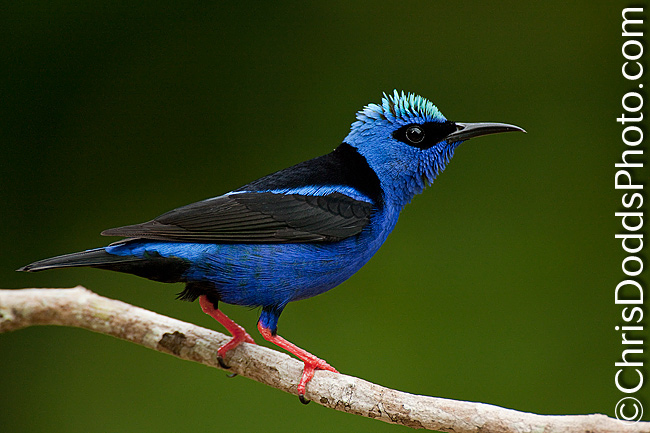 Male Red-legged Honeycreeper (Cyanerpes cyaneus) Gamboa Reserve, Panama. Image Copyright ©Christopher Dodds www.chrisdoddsphoto.com All Rights Reserved. Canon EOS 1Ds Mark III, 500mm F4 IS, 2X II Tele-converter, Canon 580 EXII Flash (manual mode) with Better Beamer, Gitzo tripod and Wimberley Head II ISO 650, F9 1/160s Manual Mode. Full Frame. The Red-legged Honeycreepers were the star performers at the hummingbird feeders during a recent photography trip to Panama. Click HERE to buy a print or license image for publication.
Male Red-legged Honeycreeper (Cyanerpes cyaneus) Gamboa Reserve, Panama. Image Copyright ©Christopher Dodds www.chrisdoddsphoto.com All Rights Reserved. Canon EOS 1Ds Mark III, 500mm F4 IS, 2X II Tele-converter, Canon 580 EXII Flash (manual mode) with Better Beamer, Gitzo tripod and Wimberley Head II ISO 650, F9 1/160s Manual Mode. Full Frame. The Red-legged Honeycreepers were the star performers at the hummingbird feeders during a recent photography trip to Panama. Click HERE to buy a print or license image for publication.
Book Review: Nature Photography Learning from a Master
Published in 2003, before the advent of professional digital cameras, this is still among my favorite go-to books for inspiration and creative techniques. Using this exceptional book as a guide, would-be nature photographers embark on a journey of learning and discovery as they master, step by step, the technical know-how they will need to achieve excellent results when venturing into the wild with camera in hand. Beginning with the basics of selecting equipment and moving on to the essential photographic techniques of exposure, focus, and lighting, the book then offers tips on how to compose a shot, how to get close-ups, and how to explore the possibilities of medium-format, large-format, and panoramic cameras.
The striking color photographs-of seals in Antarctica, zebras on the savanna, rhinoceroses in the tropical forest, and much more-are of a quality seldom found in how-to manuals. Fascinating and beautiful in their own right, they illustrate the challenges and joys that are the rewards of nature photography, and will inspire many to take to the sea, to the air, and to an array of different environments to capture their photographic prey. The book concludes with useful strategies for making the leap from talented amateur to professional photographer.
Gilles Martin has been a photographer for more than 30 years, capturing nature in all of its variety and richness. His subjects have ranged from the 12-foot baleen whale to minuscule insects. His work has appeared internationally in such publications as GEO, Paris Match, Life, and National Geographic. Denis Boyard, a journalist and photographer, is the chief technical editor of the magazine Chasseur d'Images.
Canon 1D Mark IV
Canon's latest professional digital SLR (Single Lens Reflex) camera has now shipped. If you've been holding off to see how it's autofocus system works, then here's some reviews:
An analysis of EOS-1D Mark IV autofocus performance by Rob Galbraith
Canon EOS-1D Mark IV Review by Richard Butler on dpreview.com
Canon EOS 1D Mark IV White Paper from Canon
Let's not forget Haiti!
Thick-billed Euphonia
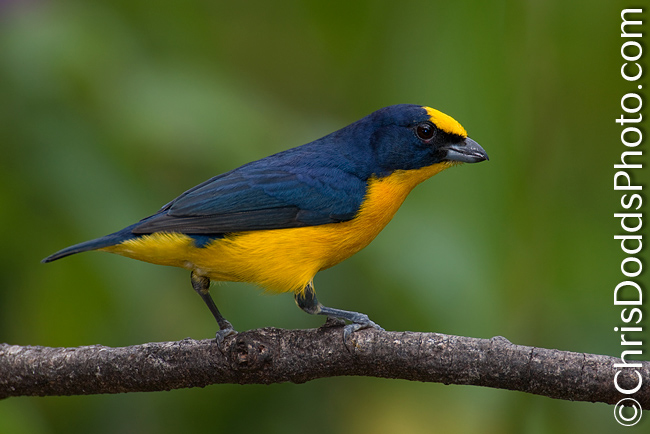 Male Thick-billed Euphonia (Euphonia Laniirostris) Canopy Lodge, El Valle de Antón, Panama. Image Copyright ©Christopher Dodds www.chrisdoddsphoto.com All Rights Reserved. Canon EOS 1Ds Mark III, 500mm F4 IS, 2X II Tele-converter, Canon 580 EXII Flash (manual mode) with Better Beamer, Gitzo tripod and Wimberley Head II ISO 250, F8 1/160s Manual Mode. Full Frame. Click HERE to order a print or license image for publication.
Male Thick-billed Euphonia (Euphonia Laniirostris) Canopy Lodge, El Valle de Antón, Panama. Image Copyright ©Christopher Dodds www.chrisdoddsphoto.com All Rights Reserved. Canon EOS 1Ds Mark III, 500mm F4 IS, 2X II Tele-converter, Canon 580 EXII Flash (manual mode) with Better Beamer, Gitzo tripod and Wimberley Head II ISO 250, F8 1/160s Manual Mode. Full Frame. Click HERE to order a print or license image for publication.
Christopher Dodds Photo Safaris
Why a Christopher Dodds Nature Photography Workshop? I'll let my clients (many repeats) tell you HERE.
Photographing Frogs: Endangered Species of Panama.
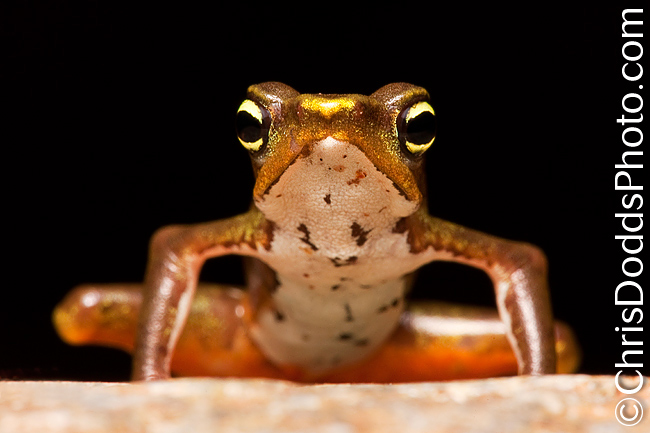 Harlequin Toad (Atelopus limosus). Provincia de Colón, Panama. Image Copyright ©Christopher Dodds www.chrisdoddsphoto.com All Rights Reserved. Canon EOS 1DsMKIII, Sigma 150mm F2.8 Macro, Wimberley F2 Macro Flash Bracket, Canon 580 EX II Flash with LumiQuest Softbox III Hand-held. ISO 400, F16 @ 1/160s Manual mode. Full Frame. CLICK HERE TO ORDER A PRINT OR TO LICENSE IMAGE FOR PUBLICATION.
Harlequin Toad (Atelopus limosus). Provincia de Colón, Panama. Image Copyright ©Christopher Dodds www.chrisdoddsphoto.com All Rights Reserved. Canon EOS 1DsMKIII, Sigma 150mm F2.8 Macro, Wimberley F2 Macro Flash Bracket, Canon 580 EX II Flash with LumiQuest Softbox III Hand-held. ISO 400, F16 @ 1/160s Manual mode. Full Frame. CLICK HERE TO ORDER A PRINT OR TO LICENSE IMAGE FOR PUBLICATION.
Panama: Home safe
Just home from an incredible nature photography trip to Panama. By far, the most fun, rewarding and adventurous part was spending days deep in the jungle photographing highly endangered relatives of the, now extinct in the wild, Panamanian Golden Frog (Atelopus zeteki). Crawling around jungle streams after hiking through the jungle had me facing some of the very toughest tropical conditions. I was constantly soaking wet from sweat, and I could feel my own body heat reflect back onto my face each time I brought the camera to my eye to take a picture; only to have the viewfinder and my glasses constantly fog-up. There was simply no escape from the heat and humidity. I chose to bring my Canon EOS 1Ds Mark III as my primary camera body and my Canon EOS 5D Mark II as my back-up; both performed flawlessly in the very toughest of conditions. I was, however, disappointed to have my Canon 580 EX II Flash fail yet again.
I have only had conjunctivitis once before, but quickly realized it's symptoms appearing on the third morning. Facing a medical situation involving my eyes in a third world country was a somewhat worrisome task; I was afraid that the medicine would do more harm than good. Turns out that my worries were unfounded and I was able to get American made medicine over the counter at a large pharmacy chain. The infection started to clear within 24 hours and all is fine now.
Enduring mosquitoes, tick and chigger bites and an ant attack were all well worth it (yes, I did use precaution), and a visit to Dr. Rashed at the Tropical Disease Centre of the Montreal General Hospital upon my return to have the various bites, blisters, welts, marks and rashes checked-out seems to have given me a clean bill of health (though I'm still waiting for the results of the three ticks that I removed from myself after my return home). Oh, the glorious & romantic life of a nature photographer (smile).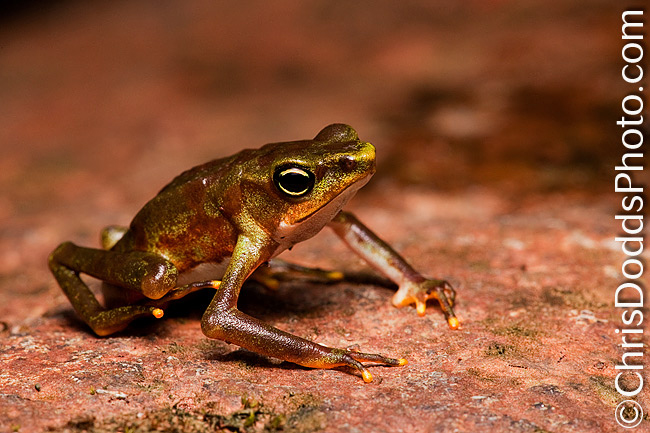 Harlequin Toad (Atelopus limosus). Provincia de Colón, Panama. Image Copyright ©Christopher Dodds www.chrisdoddsphoto.com All Rights Reserved. Canon EOS 1DsMKIII, Sigma 150mm F2.8 Macro, Wimberley F2 Macro Flash Bracket, Canon 580 EX II Flash with LumiQuest Softbox III Hand-held. ISO 640, F16 @ 1/125s Manual mode. Full Frame. CLICK HERE TO PURCHASE A PRINT OR LICENSE AN IMAGE FOR PUBLICATION.
Harlequin Toad (Atelopus limosus). Provincia de Colón, Panama. Image Copyright ©Christopher Dodds www.chrisdoddsphoto.com All Rights Reserved. Canon EOS 1DsMKIII, Sigma 150mm F2.8 Macro, Wimberley F2 Macro Flash Bracket, Canon 580 EX II Flash with LumiQuest Softbox III Hand-held. ISO 640, F16 @ 1/125s Manual mode. Full Frame. CLICK HERE TO PURCHASE A PRINT OR LICENSE AN IMAGE FOR PUBLICATION.
“Ground Beef”
After arriving in Panama City and collecting luggage, rental car and picking-up granola bars and bottles of water, I stopped for a bite at the international fast food chain symbolized by the golden arches. While waiting an unusually long time for my meal, I watched the woman at the grill drop a hamburger patty on the floor, pick it up with her spatula and replace it on the grill; I guess she thought it would sterilize it by putting it back on the heat (smile). I have always heard the rumors that there was no beef in their burgers; but now know it is, in fact, GROUND BEEF! She took a quick look around while laughing with her colleagues in the kitchen until she made eye contact with me and realized that she had been seen - then she quickly looked away and resumed making burgers. I simply walked away and decided I could wait until breakfast to eat. 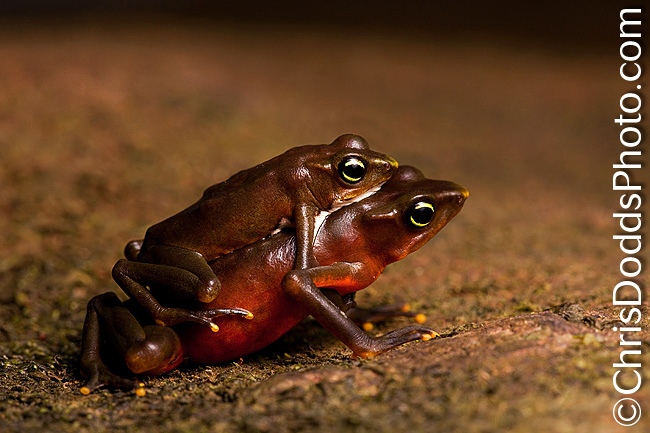 Harlequin Toads Amplectant Pair (Atelopus limosus). Provincia de Colón, Panama. Image Copyright ©Christopher Dodds www.chrisdoddsphoto.com All Rights Reserved. Canon EOS 5D mark II, Sigma 150mm F2.8 Macro, Wimberley F2 Macro Flash Bracket, Canon 580 EX II Flash with LumiQuest Softbox III Hand-held. ISO 800, F14 @ 1/160s Manual mode. Full Frame. CLICK HERE TO ORDER A PRINT OR LICENSE IMAGE FOR PUBLICATION.
Harlequin Toads Amplectant Pair (Atelopus limosus). Provincia de Colón, Panama. Image Copyright ©Christopher Dodds www.chrisdoddsphoto.com All Rights Reserved. Canon EOS 5D mark II, Sigma 150mm F2.8 Macro, Wimberley F2 Macro Flash Bracket, Canon 580 EX II Flash with LumiQuest Softbox III Hand-held. ISO 800, F14 @ 1/160s Manual mode. Full Frame. CLICK HERE TO ORDER A PRINT OR LICENSE IMAGE FOR PUBLICATION.
Harlequin Toads (Atelopus limosus) & amphibian chytrid fungus (Batrachochytrium dendrobatidis)
amphibian chytrid fungus (Batrachochytrium dendrobatidis) is a lethal fungus spreading across Central America and wiping out entire populations of frogs. The Batrachochytrium dendrobatidis is so deadly that it kills about half of all amphibian species and reduces overall populations by about 80% after it’s arrival in any given place. One third of the known 5,743 amphibian species in the world are at risk of being wiped out! On a world scale, 122 species of amphibian species have gone extinct, compared with five bird species and no mammals in the same period.
Listed by the IUCN (Red List) as endangered, the Harlequin Toad (Atelopus limosus) is also known as the Mossy Stub-footed Toad and Limosa Stubfoot Toad. An endemic species of Panama, it’s population is limited to 5,000 square kilometer range of severely fragmented forest and is at risk from Amphibian Chytrid Fungus and habitat loss.
Apple Announces Aperture 3 - FINALLY
Funny how critics blasted Apple for not announcing a new version of Aperture when Adobe released it's free beta version of Lightroom 3. I'm happy to report that Apple just released it's newest full version of Aperture. Unlike Adobe, Apple waited to release a full, working version available as an upgrade for only CAD$109.00. This new version has more than 200 new features, including the incorporation of Faces and Places from iPhoto. Apple included brushes, pre-sets and advanced slideshows with full multimedia support. If you're a Mac user, be sure to try the 30 day free trial here. If you're a PC user, then is is just another reason to make the switch to Apple (smile). I've only had limited time with Aperture 3, but kudos to Apple for waiting to offer a full version and skipping the "use your customer base as guinea-pigs" stage. Though, perhaps, early to offer a full review, my experience has been flawless so far.
Thanks for your concern
My last post was on January 22, 2010, so this is the longest I've gone without blogging. Many thanks to the many dozens of folks who emailed me to check-in and see if all was A-OK. As you can see, I was having a blast in Central America!
"Hi Chris- nice shots. I don't mean to be a purist snob, but one major concern- you can't wear insect repellent and work with amphibians- *especially* critically endangered ones. 95% of the time, they'll die with exposure - either direct touch on the mucous membrane (skin), gasseous, or otherwise."
- Joe Milmo (via Facebook)
Hi Joe,
Thank-you! Excellent points. It is also strongly recommended to wash hands frequently (or wear powder-free Nitrile gloves) and disinfect footwear (using bleach mixed with water) to stop the spread of amphibian chytrid fungus.
Very best,
Chris
The Business of Photography: The Business Plan
 Red Fox Vulpes vulvas (renard roux). Algonquin Provincial Park, Ontario. Image Copyright ©Christopher Dodds www.chrisdoddsphoto.com All Rights Reserved. Canon EOS 1DsMKII, 70-200mm F2.8 IS @ 70mm Hand-held. ISO 500, F3.2 @ 1/125s Manual mode. Ambient exposure using Sekonic L-358 Flash Master Light Meter
Red Fox Vulpes vulvas (renard roux). Algonquin Provincial Park, Ontario. Image Copyright ©Christopher Dodds www.chrisdoddsphoto.com All Rights Reserved. Canon EOS 1DsMKII, 70-200mm F2.8 IS @ 70mm Hand-held. ISO 500, F3.2 @ 1/125s Manual mode. Ambient exposure using Sekonic L-358 Flash Master Light Meter. Full Frame. CLICK HERE TO BUY A PRINT OR LICENSE IMAGE FOR PUBLICATION.
The Business Plan
One of the biggest mistakes many people starting a business make is not having a business plan. A business plan can be as simple as a Mission Statement and as complicated as you feel necessary. Think of a business plan as a roadmap; Where are you going?, How are you getting there? Are you headed in the right direction? and what to do if you make a wrong turn. A well written business plan is also a great tool to measure your successes and failures as a business person if reviewed periodically.
I don’t want to deceive you, so I’ll make it clear to you now that I don’t know any other photographers that actually have a business plan. I am asked, quite often, how to get into Nature or Wildlife Photography as a profession. I also have regular conversations with other successful photographer friends (Jewelry and studio photographers) about how they plan on getting to the next level; both as a photographer and as a business person. A well written business plan will help you see where you want to go, and how to get there.
I’m sure you all have a plan and have though about where you want to be in five or ten years. All I’m suggesting is putting it in writing and making it an annual event to review and modify things. How often have you had a great plan or idea, only to forget it within a short period of time?
Here’s some simple steps to a successful Business Plan:
Define who you are as a photographer and identify key strengths and weaknesses. Review your photography and identify a specialty and or passion. What makes your clients choose you and why are you different than a stock agency or other photographer? Create an executive summary, or mission statement, that will become the first part of your business plan. This need only be a few sentences long and it is essentially a summary of your findings.
Define your market as a photographer. In what area of photography do you see yourself fitting best? Who are your potential clients? Do you want to sell image rights for publication? or sell fine art prints to collectors? or both? What age group and gender are those clients. If you want to sell images to magazines for publication, who works for the magazines, and who buys those magazines? This section is a summary of your product, your service and your target clients.
Define your Competition. Now you know who you are, what product, or service you offer and who is your likely client. It’s time to think about who else is out there doing the same thing as you, and why you are a better, more logical choice for your client. What do you offer that your competitors don’t?
The last section deals with finances. Identify how much money you need to make to keep your head above water without falling into debt. Essentially a spreadsheet with a list of your expenses that should include: Living expenses like food, clothing, housing (mortgage, insurance, taxes and repairs), Utilities (heat, air conditioning, electricity, gas, water, etc) Transportation (Car payment, Insurance, fuel and repair) and health / disability insurance. Don't forget contributions to an emergency fund; you never know when you have to replace a roof or have a sudden financial crisis. Make a list of the monthly costs and multiply by 12 to figure out just how much money you need (after taxes) to survive a year without falling into debt.
Once you establish how much you need, it’s time to figure out how, or if, you can get there. How much do you sell your product, or service for?, and how much does it cost to produce? If you are a wildlife photographer, then you should make a list of your overhead expenses like photography equipment (cameras, lens, etc.), Office, or production, equipment (computers, printers, etc.), travel (transportation, lodging and food) expenses, professional services (like accounting), business liability & equipment insurance, equipment repair and rental, advertising and promotion costs, office supplies and communications (telephone, internet and mobile phone). You get the picture.
Now add your annual personal expenses (plus income tax) to your annual professional expenses. Do you think it is feasible to sell enough product or service to cover these expenses? Let’s say you sell fine art prints for $100.00 each. You determine your material cost to be $32.00 (ink and paper). You have a gross profit of $68.00. How many prints (think $68.00) do you need to keep yourself afloat? how many do you need to sell to put some savings aside for a bad year (or two) or a catastrophic medical or mental event? (laugh, but most business people suffer one, or the other, at some point in their career) oh, did you think about retirement savings? ... Perhaps a few more than you initially thought - but you knew that, right? (smile).
Now that you have a plan in writing, it's much easier to stay on track. If you make the small effort to review and ammend your plan from time to time, you have a much better understanding of where you have come from, where you are and where you are going.
The Fundamentals of Photography: Understanding the Light Meter
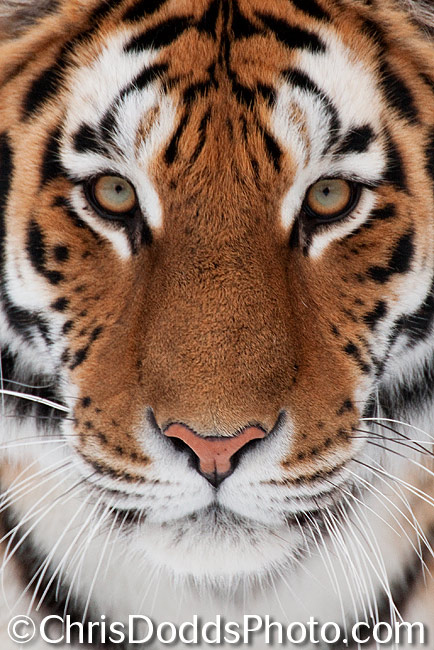
Siberian (Amur) Tiger Portrait Panthera tigris altaica (Tigre de L'Amour ou Tigre de Sibérie). CAPTIVE ANIMAL. Image Copyright ©Christopher Dodds www.chrisdoddsphoto.com All Rights Reserved. Canon EOS 1DsMKIII, 500mm F4 IS, 2X II Tele-converter Gitzo 1325 Tripod with Wimberley Head II. ISO 800, F8 @ 1/160s Manual mode. Ambient exposure using hand-held Sekonic L-358 Light Meter. Full Frame. CLICK HERE TO PURCHASE A PRINT or LICENSE IMAGE FOR PUBLICATION.
The in-Camera Light Meter:
Pretty much all digital cameras sold today include a built-in REFLECTIVE light meter. The volume of light measured by a reflective light meter varies relative to the color (or reflectance) of the subject, the background (and the subjects distance from it) and the chosen metering mode (or pattern); A Snowy Owl in a bright, snowy field reflects more light than a black bear on a dark, wet rock. Think of it this way: pure white reflects nearly all of the light that strikes it, and pure black reflects virtually none of the light that strikes it.
Left to it’s own devises, a digital camera in one of it’s automatic modes (Program, Aperture Priority or Shutter Priority) will use it’s built-in computer processor and programmed algorithms to determine the appropriate exposure settings such as shutter speed, f-stop (or aperture) and ISO to render the scene at what it thinks should be 18% grey, or a mid-tone (exactly mid way between the blackest black and the whitest white). The problem is a simple one; most cameras assume that everything they photograph reflects 18% of the light that falls onto them. Not everything we see or photograph is a mid-tone; with this method, we need to compensate to achieve the correct exposure for anything that is not a mid-tone; The Snowy Owl in a Snowy field we talked about earlier would be about two stops under-exposed, so we need to add about two stops of light to the metered reading to achieve the correct exposure. The black bear on the dark, wet rock will be about two stops overexposed, so we have to remove about two stops of light from the metered reading to achieve the correct exposure. A picture of the green grass on your front lawn is a middle tone and requires no compensation to achieve the correct exposure.
The problem gets much bigger when your subject starts to move from one colored background to another, or, moves closer or further away; can you imagine dialing in the correct exposure compensation, on the fly, as a white bird flies from a blue sky background to a dark cliff face background as it gets bigger in the frame while flying toward you? (smile) ... I didn’t think so.
Hand-held Light Meter:
The single best teaching aid that I know of is a hand-held light meter; students wanting to learn exposure theory tend to improve the exposure accuracy of their captures almost instantly when handed a hand-held light meter.
In it’s simplest form, a light meter measures light; We’ve discussed how your camera uses it’s meter to measure the light that is reflected from your subject, now let’s talk about how to measure the ambient light that falls onto your subject by using a hand-held light meter. If we can measure the AMBIENT light that falls onto the subject, we can successfully expose for the light (not the subject), and capture colors and tones as our eyes see them; white looks white, black looks black and middle tones still look like middle tones; just the same as our eyes see them. As long as you are in the same light as your subject, and the volume of light does not change between measurement and capture, you can take a reading and lock and load the chosen ISO, F-stop and shutter speed. Just like the sunny F/16 rule in my last post, you should still use your camera’s histogram to tweak the exact exposure to taste, and you should expose to the right and maximize that right most fifth of the histogram, as it contains 50% of the data in a digital capture. I typically add light to extract maximum detail from very dark subjects and remove light from very bright subjects, all the while ensuring I’m not clipping unrecoverable highlight detail.
On a clear day, from two hours after sunrise, until two hours before sunset, the light remains constant (provided it doesn't get cloudy, of course). If your subject flies from the blue sky to a dark cliff face, there is no need to make adjustments to your chosen exposure settings; the subject will be correctly exposed in manual mode.
A major difference between the old film days and digital is that instead of exposing for shadow detail on film, we now expose for the highlight. To ensure a correct exposure for the highlights, simply turn the meter’s dome toward the light source. To take a reading for the underside of a bird flying over your head, turn the dome toward the ground and to establish the correct reading for a subject in the shade, point the dome toward the light source and use your hand to shade the dome. It won’t take long to learn all about light, it’s volume and the correct exposure relative to it.
There are many light meters to choose from, but I find the best value to be the Sekonic L-358 Flash Master Light Meter
